Hispanic and Latino Americans
In the United States, Hispanic and Latino Americans (Spanish: estadounidenses hispanos y latinos) are Americans who are descendants of people from Spain and Latin America.[6][7][8] More generally, these demographics include all Americans who identify as Hispanic and/or Latino (regardless of ancestry).[9][10][11][12] As of 2018, the Census Bureau estimated that there were almost 60 million Hispanics living in the United States (about 18% of the overall population).[13]
| Total population | |
|---|---|
| c. 59,763,631[1] 18.3% of the total U.S. population (2018)[1] | |
| Regions with significant populations | |
| |
| Languages | |
| Religion | |
| Predominantly Christian: Roman Catholic;[2] minority of Protestants,[2] Irreligious,[3] other religions[2][4] | |
| Related ethnic groups | |
"Origin" can be viewed as the ancestry, nationality group, lineage or country of birth of the person or the person's parents or ancestors before their arrival in the United States. People who identify as Spanish or Hispanic may be of any race.[14][15][16][17] As one of the only two specifically designated categories of ethnicity in the United States (the other being "Not Hispanic or Latino"), Hispanics form a pan-ethnicity incorporating a diversity of inter-related cultural and linguistic heritages. Most Hispanic Americans are of Mexican, Puerto Rican, Cuban, Salvadoran, Dominican, Guatemalan, or Colombian origin. The predominant origin of regional Hispanic populations varies widely in different locations across the country.[15][18][19][20][21]
Hispanic Americans are the second fastest-growing ethnic group by percentage growth in the United States after Asian Americans.[22] Hispanics overall are the second-largest ethnic group in the United States, after non-Hispanic whites. After Native Americans, Hispanics are the oldest ethnic group to inhabit much of what is today the United States. Many have Native American ancestry.[23][24][25][26] Spain colonized large areas of what is today the American Southwest and West Coast, as well as Florida. Its holdings included present-day California, New Mexico, Nevada, Arizona and Texas, all of which were part of Mexico from its independence in 1821 from Spain until the end of the Mexican–American War in 1848. Conversely, Hispanic immigrants to the New York/New Jersey metropolitan area derive from a broad spectrum of Latin American states.[27]
A study published in 2015 in the American Journal of Human Genetics, based on 23andMe data from 8,663 self-described Latinos, estimated that Latinos in the United States carried a mean of 65.1% European ancestry and 35.0% Native American ancestry. The study found that self-described Latinos from the Southwest, especially those along the Mexican border, had the highest mean levels of Native American ancestry.[28]
Terminology
The terms "Hispanic" and "Latino" refer to an ethnicity. The U.S. Census Bureau defines being Hispanic as an ethnicity, rather than a race, and thus people of this group may be of any race.[15][29][30] In a 2015 national survey of self-identified Hispanics, 56% said that being Hispanic is part of both their racial and ethnic background, while smaller numbers considered it part of their ethnic background only (19%) or racial background only (11%).[29] Hispanics may be of any linguistic background; in a 2015 survey, 71% of American Hispanics agreed that it "is not necessary for a person to speak Spanish to be considered Hispanic/Latino."[31] Hispanic people may share some commonalities in their language, culture, history, and heritage. According to the Smithsonian Institution, the term "Latino" includes peoples with Portuguese roots, such as Brazilians, as well as those of Spanish-language origin.[32][33] However, given the fact that "Latino" is derived from Latin, then the other cultures/languages that are also derived from Latin, i.e. French, Italian and Romanian, are also accurately defined as "Latinos". In the United States, many Hispanics are of both Spanish and Native American ancestry (mestizo). Others are wholly or predominantly of European or Middle Eastern ancestry or of Amerindian ancestry. Many Hispanics from the Caribbean, as well as other regions of Latin America where African slavery was widespread, may be of sub-Saharan African descent as well.[32][34]
The difference between the terms Hispanic and Latino is confusing to some. The U.S. Census Bureau equates the two terms and defines them as referring to anyone from Spain and the Spanish-speaking countries of the Americas. After the Mexican–American War concluded in 1848, term Hispanic or Spanish American was primarily used to describe the Hispanos of New Mexico within the American Southwest. The 1970 United States Census controversially broadened the definition to "a person of Mexican, Puerto Rican, Cuban, South or Central American, or other Spanish culture or origin, regardless of race". This is now the common formal and colloquial definition of the term within the United States, outside of New Mexico.[35][36] This definition is consistent with the 21st-century usage by the U.S. Census Bureau and OMB, as the two agencies use both terms Hispanic and Latino interchangeably.
Latino is a condensed form of the term "latinoamericano", the Spanish word for Latin American, or someone who comes from Latin America. The term Latino has developed a number of definitions. This definition, as "male Latin-American inhabitant of the United States",[37] is the oldest and the original definition used in the United States, first used in 1946.[37] Under this definition a Mexican American or Puerto Rican, for example, is both a Hispanic and a Latino. A Brazilian American is also a Latino by this definition, which includes those of Portuguese-speaking origin from Latin America.[38][39][40][41][42][43] Similarly, and by the same reasoning, French-Americans, Italian-Americans and Romanian-Americans are also all considered Latino.
Preference of use between the terms among Hispanics and Latinos in the United States often depends on where users of the respective terms reside. Those in the Eastern United States tend to prefer the term Hispanic, whereas those in the West tend to prefer Latino.[14]
The US ethnic designation Latino is abstracted from the longer form latinoamericano.[44] The element latino- is actually an indeclinable, compositional form in -o (i.e. an elemento compositivo) that is employed to coin compounded formations (similar as franco- in francocanadiense 'French-Canadian′, or ibero- in iberorrománico,[45] etc.).
The term Latinx (and its more restricted term Chicanx) gained currency among some in the 2010s.[46] The adoption of the X would be "[r]eflecting new consciousness inspired by more recent work by LGBTQI and feminist movements, some Spanish-speaking activists are increasingly using a yet more inclusive "x" to replace the "a" and "o," in a complete break with the gender binary."[47] Among the advocates of the term LatinX, one of most frequently cited complaints of gender bias in the Spanish language is that a group of mixed or unknown gender would be referred to as Latinos, whereas Latinas refers to a group of women only (but this is changed immediately to Latinos, if even a single man joins this female group).[48]
According to 2017 American Community Survey data, a small minority of immigrants from Brazil (2%), Portugal (2%) and the Philippines (1%) self-identify as Hispanic.[13]
History
16th and 17th centuries

Spanish explorers were pioneers in the territory of the present-day United States. The first confirmed European landing in the continental United States was by Juan Ponce de León, who landed in 1513 at a lush shore he christened La Florida. In the next three decades, the Spanish became the first Europeans to reach the Appalachian Mountains, the Mississippi River, the Grand Canyon and the Great Plains. Spanish ships sailed along the East Coast, penetrating to present-day Bangor, Maine, and up the Pacific Coast as far as Oregon. From 1528 to 1536, Álvar Núñez Cabeza de Vaca and three fellows (including an African named Estevanico), from a Spanish expedition that foundered, journeyed from Florida to the Gulf of California. In 1540, Hernando de Soto undertook an extensive exploration of the present United States. That same year Francisco Vásquez de Coronado led 2,000 Spaniards and Mexican Indians across today's Arizona–Mexico border and traveled as far as central Kansas, close to the exact geographic center of what is now the continental United States. Other Spanish explorers of the US territory include, among others: Alonso Alvarez de Pineda, Lucas Vázquez de Ayllón, Pánfilo de Narváez, Sebastián Vizcaíno, Gaspar de Portolà, Pedro Menéndez de Avilés, Álvar Núñez Cabeza de Vaca, Tristán de Luna y Arellano and Juan de Oñate, and non-Spanish explorers working for the Spanish Crown, such as Juan Rodríguez Cabrillo. In 1565, the Spanish created the first permanent European settlement in the continental United States, at St. Augustine, Florida. Spanish missionaries and colonists founded settlements in Santa Fe, New Mexico, El Paso, San Antonio, Tucson, Albuquerque, San Diego, Los Angeles and San Francisco, to name a few. [49]

18th and 19th centuries
| Historical population | |||
|---|---|---|---|
| Census | Pop. | %± | |
| 1850 | 116,943 | — | |
| 1880 | 393,555 | — | |
| 1900 | 503,189 | — | |
| 1910 | 797,994 | 58.6% | |
| 1920 | 1,286,154 | 61.2% | |
| 1930 | 1,653,987 | 28.6% | |
| 1940 | 2,021,820 | 22.2% | |
| 1950 | 3,231,409 | 59.8% | |
| 1960 | 5,814,784 | 79.9% | |
| 1970 | 8,920,940 | 53.4% | |
| 1980 | 14,608,673 | 63.8% | |
| 1990 | 22,354,059 | 53.0% | |
| 2000 | 35,305,818 | 57.9% | |
| 2010 | 50,477,594 | 43.0% | |
| Est. 2017 | 58,846,134 | 16.6% | |
| Source: Historical Census Statistics[50] | |||
As late as 1783, at the end of the American Revolutionary War (a conflict in which Spain aided and fought alongside the rebels), Spain held claim to roughly half the territory of today's continental United States. From 1819 to 1848, the United States (through treaties, purchase, diplomacy, and the Mexican–American War) increased its area by roughly a third at Spanish and Mexican expense, acquiring its three currently most populous states—California, Texas and Florida.
20th and 21st centuries
During the 20th and 21st centuries, Hispanic and Latino immigration to the United States increased markedly following changes to the immigration law in 1965.
Hispanic and Latino contributions in the historical past and present of the United States are addressed in more detail below (See Notables and their contributions). To recognize the current and historic contributions of Hispanic and Latino Americans, on September 17, 1968, President Lyndon B. Johnson designated a week in mid-September as National Hispanic Heritage Week, with Congress's authorization. In 1988, President Ronald Reagan extended the observance to a month, designated National Hispanic Heritage Month.[51]
Demographics
As of 2017, Hispanics accounted for 18% of the U.S. population, or almost 59 million people.[53] The Hispanic growth rate over the April 1, 2000 to July 1, 2007, period was 28.7%—about four times the rate of the nation's total population growth (at 7.2%).[54] The growth rate from July 1, 2005, to July 1, 2006, alone was 3.4%[55]—about three and a half times the rate of the nation's total population growth (at 1.0%).[54] Based on the 2010 census, Hispanics are now the largest minority group in 191 out of 366 metropolitan areas in the United States.[56] The projected Hispanic population of the United States for July 1, 2050 is 132.8 million people, or 30.2% of the nation's total projected population on that date.[57]
Geographic distribution
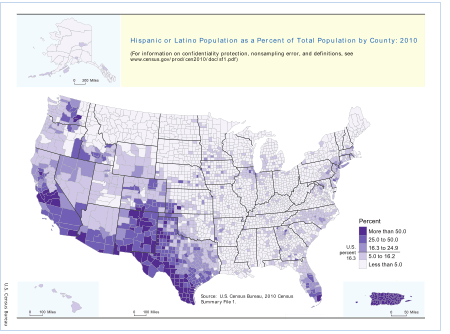
US Metropolitan Statistical Areas with over 1 million Hispanics (2014)[58]
| Rank | Metropolitan area | Hispanic population |
Percent Hispanic |
|---|---|---|---|
| 1 | Los Angeles-Long Beach-Anaheim, CA | 5,979,000 | 45.1% |
| 2 | New York-Newark-Jersey City, NY-NJ-PA | 4,780,000 | 23.9% |
| 3 | Miami-Fort Lauderdale-West Palm Beach, FL | 2,554,000 | 43.3% |
| 4 | Houston-The Woodlands-Sugar Land, TX | 2,335,000 | 36.4% |
| 5 | Riverside-San Bernardino-Ontario, CA | 2,197,000 | 49.4% |
| 6 | Chicago-Naperville-Elgin, IL-IN-WI | 2,070,000 | 21.8% |
| 7 | Dallas-Fort Worth-Arlington, TX | 1,943,000 | 28.4% |
| 8 | Phoenix-Mesa-Scottsdale, AZ | 1,347,000 | 30.1% |
| 9 | San Antonio-New Braunfels, TX | 1,259,000 | 55.7% |
| 10 | San Diego-Carlsbad, CA | 1,084,000 | 33.3% |
| 11 | San Francisco-Oakland-Hayward, CA | 1,008,000 | 21.9% |

States and territories with the highest proportion of Hispanics (2010)
| Rank | State/territory | Hispanic population | Percent Hispanic |
|---|---|---|---|
| 1 | Puerto Rico | 3,688,455 | 98% |
| 2 | New Mexico | 953,403 | 46% |
| 3 | California | 14,013,719 | 37% |
| 4 | Texas | 9,460,921 | 37% |
| 5 | Arizona | 1,895,149 | 29% |
| 6 | Nevada | 716,501 | 26% |
| 7 | Colorado | 1,269,520 | 22% |
| 8 | Florida | 4,223,806 | 22% |
| 9 | New Jersey | 1,555,144 | 17% |
| 10 | New York | 3,416,922 | 17% |
| 11 | Illinois | 2,027,578 | 15% |
Of the nation's total Hispanic or Latino population, 49% (21.5 million) live in California or Texas.[59]
Over half of the Hispanic population is concentrated in the Southwest region, mostly composed of Mexican Americans. California and Texas have some of the largest populations of Mexicans and Central American Hispanics in the United States. The Northeast region is dominated by Puerto Ricans and Dominican Americans, having the highest concentrations of both in the country. In the Mid Atlantic region, centered on the DC Metro Area, Salvadoran Americans are the largest of Hispanic groups. Florida is dominated by Cuban Americans and Puerto Ricans. In both the Great Lakes States and the South Atlantic States, Mexicans and Puerto Ricans dominate. Mexicans dominate in the rest of the country, including the Western United States, South Central United States and Great Plains states.
National origin
| Hispanic ancestry | Population | % |
|---|---|---|
| 36,986,661 | 61.9 | |
| 5,791,453 | 9.6 | |
| 2,363,532 | 3.9 | |
| 2,306,774 | 3.8 | |
| 2,082,857 | 3.4 | |
| 1,524,743 | 2.5 | |
| 1,228,468 | 2.0 | |
| 963,930 | 1.6 | |
| 819,527 | 1.3 | |
| 717,995 | 1.2 | |
| 684,345 | 1.1 | |
| 484,445 | 0.8 | |
| 435,322 | 0.8 | |
| 434,000 | 0.7 | |
| 286,346 | 0.4 | |
| 206,219 | 0.3 | |
| 172,062 | 0.2 | |
| 154,784 | 0.2 | |
| 116,646 | 0.1 | |
| 60,013 | 0.1 | |
| 25,022 | 0.0 | |
| All other | 1,800,299 | 3.0 |
| Total | 59,763,631 | 100.0 |
As of 2018, approximately 62% of the nation's Hispanic population were of Mexican origin (see table). Another 9.6% were of Puerto Rican origin, with about 4% each of Cuban and Salvadoran and 3.4% Dominican origins. The remainder were of other Central American or of South American origin, or of origin directly from Spain. Two thirds of all Hispanic and Latino Americans were born in the United States.[61]
There are few immigrants directly from Spain, since Spaniards have historically emigrated to Latin America rather than English-speaking countries. Because of this, most Hispanics who identify themselves as Spaniard or Spanish also identify with Latin American national origin. In the 2017 Census estimate approximately 1.3 million Americans reported some form of "Spanish" as their ancestry, whether directly from Spain or not.[53]
In northern New Mexico and southern Colorado, there is a large portion of Hispanics who trace their ancestry to Spanish settlers of the late 16th century through the 17th century. People from this background often self-identify as "Hispanos", "Spanish" or "Hispanic". Many of these settlers also intermarried with local Amerindians, creating a Mestizo population.[62] Likewise, southern Louisiana is home to communities of people of Canary Islands descent, known as Isleños, in addition to other people of Spanish ancestry.
Chicanos, Californios, Nuevomexicanos and Tejanos are Americans of Spanish and/or Mexican descent. Chicanos live in the Southwest, Nuevomexicanos in New Mexico, and Tejanos in Texas. Nuevomexicanos and Tejanos are distinct cultures with their own cuisines, dialects and musical traditions. The term "Chicano" became popular amongst Mexican Americans in the 1960s during the Chicano nationalism and Chicano Movement, and is today seen as an ethnic and cultural identity by some. Political activist César Chávez and novelist José Antonio Villarreal are famous Chicanos.
Nuyoricans are Americans of Puerto Rican descent from the New York City area. There are close to two million Nuyoricans in the United States. Famous Nuyoricans include Congresswomen Alexandria Ocasio-Cortez, US Supreme Court Judge Sonia Sotomayor, and singer Jennifer Lopez.
Race
| Hispanic and Latino Americans by race (2017)[63] | ||
|---|---|---|
| Race | Population | % |
| White | 38,222,255 | 65.0 |
| Some other race | 15,719,042 | 26.7 |
| Two or more races | 2,782,900 | 4.7 |
| Black | 1,263,898 | 2.1 |
| American Indian and Alaska Native |
581,116 | 1.0 |
| Asian | 215,482 | 0.4 |
| Native Hawaiian and Pacific Islander |
61,441 | 0.1 |
| Total | 58,846,134 | 100.0 |

Hispanic or Latino origin is independent of race and is termed "ethnicity" by the United States Census Bureau. The overwhelmingly majority of Latinos descend from a mixture of Spanish and Native Americans, and depending on the regions within Latin America, a significant proportion also have high to moderate or low levels of colonial era Sub-Saharan African input. Similarly to Spaniards, Portuguese, English, German and many other European nations over the centuries, many Latin Americans also possess colonial era New Christian Sephardic Jewish ancestry. To a lesser extent other Latin Americans possess at least partial ancestry of more recent post-colonial ancestry from Ashkenazi Jews, Levantine Arabs (Lebanese, Syrian and Palestinian), as well as Chinese and Japanese among others. Thus, as a whole, Latin Americans are a multiracial population, with degrees of admixture levels that vary from person to person, from varying global genetic sources. According to the 2017 American Community Survey, 65% of Hispanic and Latinos identified as White. The largest numbers of those who consider themselves White Hispanics come from within the Mexican, Puerto Rican, Cuban, Colombian and Spanish communities.[66][67]
Over a quarter of Hispanic/Latino Americans identify as "some other race."[63] These "Some other race" Hispanics are usually assumed to be mestizos or mulattos.[68] A significant percentage of the Hispanic and Latino population self-identifies as Mestizo, particularly the Mexican and Central American community. Mestizo is not a racial category in the U.S. Census, but signifies someone who is conscious of their Native American ancestry with some European ancestry. Of all Americans who checked the box "Some Other Race", 97 percent were Hispanic.
Almost one third of the multi-race respondents were Hispanics.[68] Most of the multi-racial population in the Mexican, Salvadoran, and Guatemalan communities are of European and Native American ancestry (Mestizo), while most of the multiracial population in the Puerto Rican, Dominican, and Cuban communities are of European and African ancestry (Mulatto).

The largest numbers of Black Hispanics are from the Spanish Caribbean islands, including the Cuban, Dominican, Panamanian, and Puerto Rican communities.
The few hundred thousand Asian Hispanics are of various backgrounds, among which include Filipino mestizos with Spanish background, Asians of Latin American background (examples including Chinese Cubans and Japanese Peruvians), and those of recent mixed Asian and Hispanic background. Note that Filipinos are generally not counted as Hispanic, despite the fact that the Spanish colonized the Philippines and many Filipinos have Spanish names.
Hispanic and Latinos are racially diverse, although different "races" are usually the majority of each Hispanic group. For example, of Latinos deriving from northern Mexico, consider themselves White or acknowledge Native American ancestry with some European mixtures, while of those deriving from southern Mexican ancestry, the majority are Native American or of Native American and European Ancestry. In Guatemala, Native American and bi-racial people of Native American and European descent make the majority, while in El Salvador, whites and Bi-racial people of Native American/European descent are the majority. In the Dominican Republic the population are largely made up of people with inter-mixed ancestries, in which there are even levels of African and European ancestry, with smaller numbers of Whites and Blacks as well.
.jpg)
In Puerto Rico, people with multi-racial ancestry are the majority. There are also populations of predominantly of African descent as well as populations of American Indian descent as well as those with intermixed ancestries. Cubans are mostly of White Latin American ancestry, however there are also populations of Blacks and multi-racials as well.[69][70][70][71] The race and culture of each Hispanic/Latino country and their United States diaspora differs by history and geography.
Persons of Mexican heritage represent the bulk of the US Hispanic/Latino population. Most Mexican Americans already with a multi-generational presence in the USA predating the 1970s are of predominantly European origin mixed with Native American ancestry, while most recent Mexican Americans that have migrated or descend from migrants to the United States post 1980s are of predominantly Native American descent with varying levels of European admixture.
Official sources report the racial makeup of these Hispanic subgroups as follows, Brazil,[72] Uruguay,[72] Puerto Rico,[72] Cuba,[72] and Chile,[72] having the highest proportion of Latinos self-identifying as white for their respective countries in the US, though in raw numbers the highest number of White Latinos in the USA are Mexican Americans. As a result of their racial diversity, Hispanics form an ethnicity sharing a language (Spanish) and cultural heritage, rather than a race. The phenomenon of biracial people who are predominantly of European descent identifying as white is not limited to Hispanics or Spanish speakers but is also common among English speakers as well: researchers found that most White Americans with less than 28 percent African-American ancestry say they are White; above that threshold, people tended to describe themselves as African-American.[73]
Age
As of 2014, one third, or 17.9 million, of the Hispanic population was younger than 18 and a quarter, 14.6 million, were Millennials. This makes them more than half of the Hispanic population within the United States.[74]
Education
Hispanic or Latino K-12 education
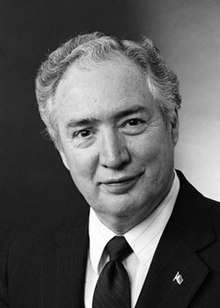
With the increasing Hispanic population in the United States, Latinos have had a considerable impact on the K-12 system. In 2011-12, Latinos comprised 24% of all enrollments in the United States, including 52% and 51% of enrollment in California and Texas, respectively.[75] Further research shows the Latino population will continue to grow in the United States, implicating that more Latinos will populate U.S schools.
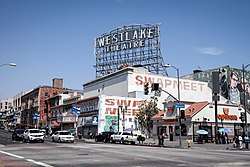
The state of Latino education shows some promise. First, Hispanic students attending pre-K or kindergarten were more likely to attend full-day programs.[75] Second, Latinos in elementary education were the second largest group represented in gifted and talented programs.[75] Third, Hispanics' average NAEP math and reading scores have consistently increased over the last 10 years.[75] Finally, Latinos were more likely than other groups, including whites, to go to college.[75]
However, their academic achievement in early childhood, elementary, and secondary education lag behind other groups.[75] For instance, their average math and reading NAEP scores were lower than every other group, except African Americans, and have the highest dropout rate of any group, 13% despite decreasing from 24%.[75]
To explain these disparities, some scholars have suggested there is a Latino "Education Crisis" due to failed school and social policies.[76] To this end, scholars have further offered several potential reasons including language barriers, poverty, and immigrant/nativity status resulting in Latinos not performing well academically.[77][78]
English language learners

Currently, Hispanic students make up 80% of English language learners in the United States.[79] In 2008-9, 5.3 million students were classified as English Language Learners (ELLs) in pre-K to 12th grade.[80] This is a result of many students entering the education system at different ages, although the majority of ELLs are not foreign born.[80] In order to provide English instruction for Latino students there have been a multitude of English Language programs. However, the great majority of these programs are English Immersion, which arguably undermines the students' culture and knowledge of their primary language.[78] As such, there continues to be great debate within schools as to which program can address these language disparities.
Immigration status
Undocumented immigrants have not always had access to compulsory education in the United States. However, due to the landmark Supreme Court case Plyler v. Doe in 1982, immigrants are allowed access to K-12 education. This significantly impacted all immigrant groups, including Latinos. However, their academic achievement is dependent upon several factors including, but not limited to time of arrival and schooling in country of origin.[81] Moreover, Latinos' immigration/nativity status plays a major role regarding their academic achievement. For instance, first- and second- generation Latinos outperform their later generational counterparts.[82] Additionally, their aspirations appear to decrease as well.[83] This has major implications on their postsecondary futures.
Hispanic higher education
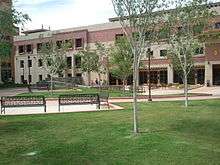
Those with a bachelor's degree or higher ranges from 50% of Venezuelans compared to 18% for Ecuadorians 25 years and older. Amongst the largest Hispanic groups, those with a bachelor's or higher was 25% for Cuban Americans, 16% of Puerto Ricans, 15% of Dominicans, and 11% for Mexican Americans. Over 21% of all second-generation Dominican Americans have college degrees, slightly below the national average (28%) but significantly higher than U.S.-born Mexican Americans (13%) and U.S.-born Puerto Rican Americans (12%).[85]
Hispanics make up the second or third largest ethnic group in Ivy League universities, considered to be the most prestigious in the United States. Hispanic and Latino enrollment at Ivy League universities has gradually increased over the years. Today, Hispanics make up between 8% of students at Yale University to 15% at Columbia University.[86] For example, 18% of students in the Harvard University Class of 2018 are Hispanic.[87]
Hispanics have significant enrollment in many other top universities such as University of Texas at El Paso (70% of students), Florida International University (63%), University of Miami (27%), and MIT, UCLA, and UC-Berkeley at 15% each. At Stanford University, Hispanics are the third largest ethnic group behind non-Hispanic Whites and Asians, at 18% of the student population.[88]
Hispanic university enrollments
While Hispanics study in colleges and universities throughout the country, some choose to attend federally-designated Hispanic-serving institutions, institutions that are accredited, degree-granting, public or private nonprofit institutions of higher education with 25 percent or more total undergraduate Hispanic full-time equivalent (FTE) student enrollment. There are over 270 institutions of higher education that have been designated as an HSI.[89]
Universities with the largest Hispanic undergraduate enrollment (2013)[90]
|
Universities with the largest Hispanic graduate enrollment (2013)
| ||||||||||||||||||||||||||||||||||||||||||||||||||||||||||||||||||||||||||||||||||||||||
Hispanic student enrollment in university and college systems (2012-2013)
|
Health
Longevity
As of 2016, life expectancy for Hispanic and Latino Americans is 81.8 years, which is higher than the life expectancy for non-Hispanic whites (78.6 years).[101] Research on the "Hispanic paradox"—the well-established apparent mortality advantage of Hispanic Americans compared to non-Hispanic whites, despite the latter's more advantaged socioeconomic status—has been principally explained by "(1) health-related migration to and from the US; and (2) social and cultural protection mechanisms, such as maintenance of healthy lifestyles and behaviors adopted in the countries of origin, and availability of extensive social networks in the US."[102] The "salmon bias" hypothesis, which suggests that the Hispanic health advantage is attributable to higher rates of return migration among less-healthy migrants, has received some support in the scholarly literature.[103] A 2019 study, examining the comparatively better health of foreign-born American Hispanics, challenged the hypothesis that a stronger orientation toward the family (familism) contributed to this advantage.[104] Some scholars have suggested that the Latino mortality advantage is likely to disappear due to the higher rates of obesity and diabetes among Latinos relative to non-Hispanic whites, although lower rates of smoking (and thus smoking-attributable mortality) among Latinos may counteract this to some extent.[102]
Healthcare
As of 2017, about 19% of Hispanic and Latino Americans lack health insurance coverage, which is the highest of all ethnic groups except for American Indians and Alaska Natives.[105] In terms of extending health coverage, Hispanics benefited the most among U.S. ethnic groups from the Affordable Care Act (ACA); among non-elderly Hispanics, the uninsured rate declined from 26.7% in 2013 to 14.2% in 2017.[105] Among the population of non-elderly uninsured Hispanic population in 2017, about 53% were non-citizens, about 39% were U.S.-born citizens, and about 9% were naturalized citizens.[105] (The ACA does not help undocumented immigrants or legal immigrants with less than five years' residence in the United States gain coverage).[105]
According to a 2013 study, Mexican women who have the highest uninsured rate (54.6%) as compared to other immigrants (26.2%), blacks (22.5%) and non-Hispanic white (13.9%).[106] According to the study, Mexican women are the largest female immigrant group in the United States and are also the most at risk for developing preventable health conditions.[107] Multiple factors such as limited access to health care, legal status and income increase the risk of developing preventable health conditions because many undocumented immigrants postpone routine visits to the doctor until they become seriously ill.
Mental health
Family separation
During the process of migrating to the United States, there are instances in their journey where families experience separation. Before the migration begins, those who are making the journey to the U.S. have to leave behind their families along with their homeland. Additionally, families who are in the process of crossing borders suffer being caught and separated by border patrol agents. Migrants are also in danger of separation if they do not have sufficient resources such as water for all members to continue crossing. Once migrants have arrived to the new country they fear workplace raids where immigrant parents are detained and deported.
Family separation puts U.S born children, undocumented children and their undocumented parents at risk for depression and family maladaptive syndrome. The effects are often long-term and the impact extends to the community level. Children will experience emotional traumas and long-term changes in behaviors. Additionally, when parents are forcefully removed, children develop feelings of abandonment and they might blame themselves for what has happened to their family. Children that are victims to family separation believe in the possibility of never seeing their parents again. These effects can cause negative parent-child attachment. Reunification may be difficult because of harsh immigration laws and re-entry restrictions which further affect the mental health of children and parents.[108]
Parents who leave behind everything in their home country also experience negative mental health experiences. According to a study published in 2013, 46% of Mexican migrant men who participated in the study reported elevated levels of depressive symptoms.[109] In recent years, the length of stay for migrants has increased, from 3 years to nearly a decade.[109] Migrants who were separated from their families, either married or single, experienced greater depression than married men accompanied by their spouses.[109] Furthermore, the study also revealed that men who are separated from their families are more prone to harsher living conditions such as overcrowded housing and are under a greater deal of pressure to send remittance to support their families. These conditions put additional stress on the migrants and often worsens their depression. Families who migrated together experience better living conditions, receive emotional encouragement and motivation from each other, and share a sense of solidarity. They are also more likely to successfully navigate the employment and health care systems in the new country, and aren't pressured to send remittances back home.
Discrimination
It is reported that 31% of Latinos have reported personal experiences with discrimination whilst 82% of Latinos believe that discrimination plays a crucial role in whether or not they will find success while they are living in the U.S.[110] The current legislation on immigration policies also plays a crucial role in creating a hostile and discriminatory environment for immigrants. In order to measure the discrimination which immigrants are being subjected to, researchers must take into account the immigrants' perception that they are being targeted for discrimination and they must also be aware that instances of discrimination can also vary based on: personal experiences, social attitudes and ethnic group barriers. The immigrant experience is associated with lower-self esteem, internalized symptoms and behavioral problems amongst Mexican youth. It is also known that more time which is spent living in the U.S. is associated with increased feelings of distress, depression and anxiety.[110] Like many other Hispanic and Latin American groups that migrate to the United States, these groups are often stigmatized. An example of this stigmatization occurred after 9/11, when people who were considered threats to national security were frequently described with terms like migrant and the "Latino Other" along with other terms like refugee and asylum seeker.[111]
Vulnerabilities
The Illegal Immigration Reform and Immigrant Responsibility Act of 1996 significantly changed how the United States dealt with immigration. Under this new law, immigrants who overstayed their visas or were found to be in the U.S illegally were subject to be detained and/or deported without legal representation. Immigrants found themselves vulnerable and living in constant fear and mistrust because they may not be allowed back into the country indefinitely. Similarly, this law made it more difficult for other immigrants who want to enter the U.S or gain legal status. These laws also expanded the types of offenses that can be considered worthy of deportation for documented immigrants.[112] Policies enacted by future presidents further limit the number of immigrants entering the country and their expedited removal.
Many immigrant families cannot enjoy doing everyday activities without exercising caution because they fear encountering immigration officers which limits their involvement in community events. Immigrant families also do not trust government institutions and services. Because of their fear of encountering immigration officers, immigrants often feel ostracized and isolated which can lead to the development of mental health issues such as depression and anxiety.[112] The harmful effects of being ostracized from the rest of society are not limited to just that of undocumented immigrants but it affects the entire family even if some of the members are of legal status. Children often reported having been victims of bullying in school by classmates because their parents are undocumented.[113] This can cause them to feel isolated and develop a sense of inferiority which can negatively impact their academic performance.
Stress
Despite the struggles Latinos families encounter, they have found ways to keep motivated. Many immigrants use religion as a source of motivation. Mexican immigrants believed that the difficulties they face are a part of God's bigger plan and believe their life will get better in the end. They kept their faith strong and pray everyday, hoping that God will keep their families safe.[114] Immigrants participate in church services and bond with other immigrants that share the same experiences.[112] Undocumented Latinos also find support from friends, family and the community that serve as coping mechanisms. Some Latinos state that their children are the reason they have the strength to keep on going. They want their children to have a future and give them things they aren't able to have themselves.[114] The community is able to provide certain resources that immigrant families need such as tutoring for their children, financial assistance, and counseling services.[112] Some identified that maintaining a positive mental attitude helped them cope with the stresses they experience. Many immigrants refuse to live their life in constant fear which leads to depression in order to enjoy life in the U.S.[114] Since many immigrants have unstable sources of income, many plan ahead in order to prevent future financial stress. They put money aside and find ways to save money instead of spend it such as learning to fix appliances themselves.[114]
Poverty
Many Latino families migrate to find better economic opportunities in order to send remittances back home. Being undocumented limits the possibilities of jobs that immigrants undertake and many struggle to find a stable job. Many Latinos report that companies turned them down because they do not have a Social Security number. If they are able to obtain a job, immigrants risk losing it if their employer finds out they are unable to provide proof of residency or citizenship. Many look towards agencies that do not ask for identification, but those jobs are often unreliable. In order to prevent themselves from being detained and deported, many have to work under exploitation. In a study, a participant reported "If someone knows that you don't have the papers. . .that person is a danger. Many people will con them. . . if they know you don't have the papers, with everything they say 'hey I'm going to call immigration on you.'".[114] These conditions lower the income that Latino families bring to their household and some find living each day very difficult. When an undocumented parent is deported or detained, income will be lowered significantly if the other parent also supports the family financially. The parent who is left has to look after the family and might find working difficult to manage along with other responsibilities. Even if families aren't separated, Latinos are constantly living in fear that they will lose their economic footing.
Living in poverty has been linked to depression, low self-esteem, loneliness, crime activities and frequent drug use among youth.[112] Families with low incomes are unable to afford adequate housing and some of them are evicted. The environment in which the children of undocumented immigrants grow up in are often composed of poor air quality, noise, and toxins which prevent healthy development.[112] Furthermore, these neighborhoods are prone to violence and gang activities, forcing the families to live in constant fear which can contribute to the development of PTSD, aggression, and depression.
Economic outlook
Median income
| Ethnicity or nationality | Income | |
|---|---|---|
| Argentinean | $60,640 | |
| Spaniards | $60,000 | |
| Venezuelan | $56,800 | |
| Peruvian | $56,000 | |
| Colombian | $54,500 | |
| Ecuadorian | $51,000 | |
| Nicaraguans | $51,000 | |
| Salvadoran | $47,600 | |
| Cubans | $44,400 | |
| Mexicans | $44,200 | |
| Puerto Ricans | $40,500 | |
| Guatemalans | $40,200 | |
| Dominicans | $36,800 | |
| Hondurans | $36,800 | |
| Sources:[115] | ||
In 2017, the US Census reported the median household incomes of Hispanic and Latino Americans to be $50,486. This is the third consecutive annual increase in median household income for Hispanic-origin households.[116]
Poverty
According to the U.S. Census, the poverty rate Hispanics was 18.3 percent in 2017, down from 19.4 percent in 2016. Hispanics accounted for 10.8 million individuals in poverty.[116] In comparison, the average poverty rates in 2017 for non-Hispanic White Americans was 8.7 percent with 17 million individuals in poverty, Asian Americans was 10.0 percent with 2 million individuals in poverty, and African Americans was 21.2 percent with 9 million individuals in poverty.[116]
Among the largest Hispanic groups during 2015 was: Honduran Americans & Dominican Americans (27%), Guatemalan Americans (26%), Puerto Ricans (24%), Mexican Americans (23%), Salvadoran Americans (20%), Cuban Americans and Venezuelan Americans (17%), Ecuadorian Americans (15%), Nicaraguan Americans (14%), Colombian Americans (13%), Spanish Americans & Argentinian Americans (11%), and Peruvian Americans (10%).[117]
Poverty affects many underrepresented students as racial/ethnic minorities tend to stay isolated within pockets of low-income communities. This results in several inequalities, such as "school offerings, teacher quality, curriculum, counseling and all manner of things that both keep students engaged in school and prepare them to graduate."[118] In the case of Latinos, the poverty rate for Hispanic children in 2004 was 28.6 percent.[79] Moreover, with this lack of resources, schools reproduce these inequalities for generations to come. In order to assuage poverty, many Hispanic families can turn to social and community services as resources.
Cultural matters
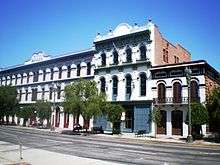
The geographic, political, social, economic and racial diversity of Hispanic and Latino Americans makes all Hispanics very different depending on their family heritage and/or national origin. Yet several features tend to unite Hispanics from these diverse backgrounds.
Language
Spanish
| Year | Number of speakers |
Percent of population |
|---|---|---|
| 1980 | 11.0 million | 5% |
| 1990 | 17.3 million | 7% |
| 2000 | 28.1 million | 10% |
| 2010 | 37.0 million | 13% |
| 2012 | 38.3 million | 13% |
| 2020* | 40.0 million | 14% |
| *-Projected; sources:[119][120][121][122] | ||
As one of the most important uniting factors of Hispanic Americans, Spanish is an important part of Hispanic culture. Teaching Spanish to children is often one of the most valued skills taught amongst Hispanic families. Spanish is not only closely tied with the person's family, heritage, and overall culture, but valued for increased opportunities in business and one's future professional career. A 2013 Pew Research survey showed that 95% of Hispanic adults said "it's important that future generations of Hispanics speak Spanish."[119][123] Given the United States' proximity to other Spanish-speaking countries, Spanish is being passed on to future American generations. Amongst second-generation Hispanics, 80% speak fluent Spanish, and amongst third-generation Hispanics, 40% speak fluent Spanish.[124] Spanish is also the most popular language taught in the United States.[125][126]
Hispanics have revived the Spanish language in the United States. First brought to North America by the Spanish during the Spanish colonial period in the 16th century, Spanish was the first European language spoken in the Americas. Spanish is the oldest European language in the United States, spoken uninterruptedly for four and a half centuries, since the founding of Saint Augustine, Florida in 1565.[127][128][129][130] Today, 90% of all Hispanics and Latinos speak English, and at least 78% speak fluent Spanish.[131] Additionally, 2.8 million non-Hispanic Americans also speak Spanish at home for a total of 41.1 million.[132]
With 40% of Hispanic and Latino Americans being immigrants,[133] and with many of the 60% who are U.S.-born being the children or grandchildren of immigrants, bilingualism is the norm in the community at large. At home, at least 69% of all Hispanics over the age of five are bilingual in English and Spanish, whereas up to 22% are monolingual English-speakers, and 9% are monolingual Spanish speakers. Another 0.4% speak a language other than English and Spanish at home.[131]
American Spanish dialects
The Spanish dialects spoken in the United States differ depending on the country of origin of the person or the person's family heritage. However, generally, Spanish spoken in the Southwest is Mexican Spanish (or Chicano Spanish). An old, colonial variety of Spanish is spoken by descendants of the early Spanish colonists in New Mexico and Colorado, which is New Mexican Spanish. One of the major distinctions of New Mexican Spanish is its heavy use of colonial vocabulary and verb tenses that make New Mexican Spanish uniquely American amongst Spanish dialects. The Spanish spoken in the East Coast is Caribbean Spanish and is heavily influenced by the Spanish of Cuba, the Dominican Republic, and Puerto Rico. Canarian Spanish is the historic Spanish dialect spoken by the descendants of the earliest Spanish colonists beginning in the 18th century in Louisiana. Spanish spoken elsewhere throughout the country varies, although is generally Mexican Spanish.[132][134]
Most generations of descendants of immigrants after the first generation of Spanish speakers tend to speak the Spanish language with accents of American English of the region in which they grew up.
Spanglish and English dialects
Hispanics have influenced the way Americans speak with the introduction of many Spanish words into the English language. Amongst younger generations of Hispanics, Spanglish, or a mix of Spanish and English, may be a common way of speaking. Although they are fluent in both languages, speakers will switch between Spanish and English throughout the conversation. Spanglish is particularly common in Hispanic-majority cities and communities such as Miami, Hialeah, San Antonio, Los Angeles and New York City.[135]
Hispanics have also influenced the way English is spoken in the United States. In Miami, for example, the Miami dialect has evolved as the most common form of English spoken and heard in Miami today. This is a native dialect of English, and was developed amongst second and third generations of Cuban Americans in Miami. Today, it is commonly heard everywhere throughout the city. Gloria Estefan and Enrique Iglesias are examples of people who speak with the Miami dialect. Another major English dialect, is spoken by Chicanos and Tejanos in the Southwestern United States, called Chicano English. George Lopez and Selena are examples of speakers of Chicano English.[136] An English dialect spoken by Puerto Ricans and other Hispanic groups is called New York Latino English.
Religion
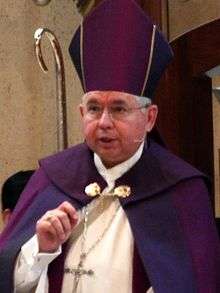
A Pew Center study in 2019, found that the majority of Hispanic Americans are Christians (72%),[137] Among American Hispanics, as of 2018–19, 47% are Catholic, 24% are Protestant, 1% are Mormon, fewer than 1% are Orthodox Christian, 3% are members of non-Christian faiths, and 23% are unaffiliated.[137] The proportion of Hispanics who are Catholic has dropped from 2009 (when it was 57%), while the proportion of unaffiliated Hispanics has increased since 2009 (when it was 15%).[137] Among Hispanic Protestant community, most are evangelical, but some belong to mainline denominations.[138] Compared to Catholic, unaffiliated, and mainline Protestant Hispanics, Evangelical Protestant Hispanics are substantially more likely to attend services weekly, pray daily, and adhere to biblical liberalism.[138] As of 2014, about 67% of Hispanic Protestants and about 52% of Hispanic Catholics were renewalist, meaning that they described themselves as Pentecostal or charismatic Christians (in the Catholic tradition, called Catholic Charismatic Renewal).[139]
Catholic affiliation is much higher among first-generation than it is among second- or third-generation Hispanic or Latino immigrants, who exhibit a fairly high rate of conversion to Protestantism.[140] According to Andrew Greeley, as many as 600,000 American Latinos leave Catholicism for Protestant churches every year.[141] Hispanic or Latino Catholics are developing youth and social programs to retain members.[142]
Hispanics make up a substantial proportion (almost 40%) of the Catholics in the United States,[143] although the number of American Hispanic priests is low relative to Hispanic membership in the church.[144] In 2019, José Horacio Gómez, Archbishop of Los Angeles and a naturalized American citizen born in Mexico, was elected as president of the U.S. Conference of Catholic Bishops.[143]
Media
The United States is home to thousands of Spanish-language media outlets, which range in size from giant commercial and some non-commercial broadcasting networks and major magazines with circulations numbering in the millions, to low-power AM radio stations with listeners numbering in the hundreds. There are hundreds of Internet media outlets targeting U.S. Hispanic consumers. Some of the outlets are online versions of their printed counterparts and some online exclusively.
Increased use of Spanish-language media leads to increased levels of group consciousness, according to survey data. The differences in attitudes are due to the diverging goals of Spanish-language and English-language media. The effect of using Spanish-language media serves to promote a sense of group consciousness among Latinos by reinforcing roots in Latin America and the commonalities among Latinos of varying national origin.[145][146]
The first Latino-American owned major film studio in the U.S. is based in Atlanta, Georgia. In 2017, Ozzie and Will Areu purchased Tyler Perry's former studio to establish Areu Bros. Studios.[147][148]
Radio
Spanish language radio is the largest non-English broadcasting media.[149] While other foreign language broadcasting declined steadily, Spanish broadcasting grew steadily from the 1920s to the 1970s. The 1930s were boom years.[150] The early success depended on the concentrated geographical audience in Texas and the Southwest.[151] American stations were close to Mexico which enabled a steady circular flow of entertainers, executives and technicians, and stimulated the creative initiatives of Hispanic radio executives, brokers, and advertisers. Ownership was increasingly concentrated in the 1960s and 1970s. The industry sponsored the now-defunct trade publication Sponsor from the late 1940s to 1968.[152] Spanish-language radio has influenced American and Latino discourse on key current affairs issues such as citizenship and immigration.[153]
Networks
Notable Hispanic/Latino-oriented media outlets include:
- Univisión, the largest Spanish-language television network in the United States, with affiliates in nearly every major U.S. market, and numerous affiliates internationally. It is the country's fourth-largest network overall;[154]
- El Rey Network, an English television channel targeting Latino audiences with Grindhouse-style content. Its headquarters are in Austin, Texas;
- Fusion TV, an English television channel targeting Hispanic audiences with news and satire programming.
- Telemundo, the second-largest Spanish-language television network in the United States, with affiliates in nearly every major U.S. market, and numerous affiliates internationally;
- Universo, a cable network that produces content for U.S.-born Hispanic and Latino audiences;
- Azteca América, a Spanish-language television network in the United States, with affiliates in nearly every major U.S. market, and numerous affiliates internationally;
- TBN Enlace USA, a Spanish-language Christian television network based in Tustin, California;
- 3ABN Latino, a Spanish-language Christian television network based in West Frankfort, Illinois;
- V-me, a Spanish-language television network
- Primo TV, an English-language cable channel aimed at Hispanic youth.
- CNN en Español, a Spanish-language all-news television network based in Atlanta, Georgia;
- ESPN Deportes and Fox Deportes, two Spanish-language sports television networks.
- Fuse, a former music channel that merged with the Latino-oriented NuvoTV in 2015.
Print
- La Opinión, a Spanish-language daily newspaper published in Los Angeles, California and distributed throughout the six counties of Southern California. It is the largest Spanish-language newspaper in the United States;
- El Nuevo Herald and Diario Las Américas, Spanish-language daily newspapers serving the greater Miami, Florida market;
- El Tiempo Latino a Spanish-language free-circulation weekly newspaper published in Washington, D.C..
- Latina, a magazine for bilingual, bicultural Hispanic women
- People en Español, a Spanish-language magazine counterpart of People;
- Vida Latina, a Spanish-language entertainment magazine distributed throughout the Southern United States.
Cuisine
Latino food, particularly Mexican food, has influenced American cuisine and eating habits. Mexican cuisine has become so mainstream in American culture that many no longer see it as an ethnic food. Across the United States, tortillas and salsa are arguably becoming as common as hamburger buns and ketchup. Tortilla chips have surpassed potato chips in annual sales, and plantain chips popular in Caribbean cuisines have continued to increase sales.[155] Tropical fruit, such as mango, guava, and passion fruit (maracuyá), have become more popular and are now common flavors in desserts, candies, and food dishes in the United States.
Due to the large Mexican-American population in the Southwestern United States, and its proximity to Mexico, Mexican food there is believed to be some of the best in the United States. Cubans brought Cuban cuisine to Miami, and today, cortaditos, pastelitos de guayaba, and empanadas are common mid-day snacks in the city. Cuban culture has changed Miami's coffee drinking habits, and today a café con leche or a cortadito is commonly had, often with a pastelito (pastry), at one of the city's numerous coffee shops.[156] The Cuban sandwich developed in Miami, and is now a staple and icon of the city's cuisine and culture.[157]
Familial situations
Family life and values

Hispanic and Latino culture places a strong value on family, and is commonly taught to Hispanic children as one of the most important values in life. Statistically, Hispanic families tend to have larger and closer knit families than the American average. Hispanic families tend to prefer to live near other family members. This may mean that three or sometimes four generations may be living in the same household or near each other, although four generations is uncommon in the United States. The role of grandparents is believed to be very important in the upbringing of children.[158]
Hispanics tend to be very group-oriented, and an emphasis is placed on the well-being of the family above the individual. The extended family plays an important part of many Hispanic families, and frequent social, family gatherings are common. Traditional rites of passages, particularly Roman Catholic sacraments: such as baptisms, birthdays, First Holy Communions, quinceañeras, Confirmations, graduations and weddings are all popular moments of family gatherings and celebrations in Hispanic families.[159][160]
Education is another important priority for Hispanic families. Education is seen as the key towards continued upward mobility in the United States among Hispanic families. A 2010 study by the Associated Press showed that Hispanics place a higher emphasis on education than the average American. Hispanics expect their children to graduate university.[161][162]
Latin American youth today stay at home with their parents longer than before. This is due to more years spent studying and the difficulty of finding a paid job that meets their aspirations.[163]
Intermarriage

Hispanic Americans, like immigrant groups before them, are out-marrying at high rates. Out-marriages comprised 17.4% of all existing Hispanic marriages in 2008.[164] The rate was higher for newlyweds (which excludes immigrants who are already married): Among all newlyweds in 2010, 25.7% of all Hispanics married a non-Hispanic (this compares to out-marriage rates of 9.4% of whites, 17.1% of blacks, and 27.7% of Asians). The rate was larger for native-born Hispanics, with 36.2% of native-born Hispanics (both men and women) out-marrying compared to 14.2% of foreign-born Hispanics.[165] The difference is attributed to recent immigrants tending to marry within their immediate immigrant community due to commonality of language, proximity, familial connections, and familiarity.[164]
In 2008, 81% of Hispanics who married out married non-Hispanic Whites, 9% married non-Hispanic Blacks, 5% non-Hispanic Asians, and the remainder married non-Hispanic, multi-racial partners.[164]
Of approximately 275,500 new interracial or interethnic marriages in 2010, 43.3% were White-Hispanic (compared to White-Asian at 14.4%, White-Black at 11.9%, and other combinations at 30.4%; "other combinations" consists of pairings between different minority groups, multi-racial people, and American Indians).[165] Unlike those for marriage to Blacks and Asians, intermarriage rates of Hispanics to Whites do not vary by gender. The combined median earnings of White/Hispanic couples are lower than those of White/White couples but higher than those of Hispanic/Hispanic couples. 23% of Hispanic men who married White women have a college degree compared to only 10% of Hispanic men who married a Hispanic woman. 33% of Hispanic women who married a White husband are college-educated compared to 13% of Hispanic women who married a Hispanic man.[165]
Attitudes among non-Hispanics toward intermarriage with Hispanics are mostly favorable, with 81% of Whites, 76% of Asians, and 73% of Blacks "being fine" with a member of their family marrying a Hispanic and an additional 13% of Whites, 19% of Asians, and 16% of Blacks "being bothered but accepting of the marriage." Only 2% of Whites, 4% of Asians, and 5% of Blacks would not accept a marriage of their family member to a Hispanic.[164]
Hispanic attitudes toward intermarriage with non-Hispanics are likewise favorable, with 81% "being fine" with marriages to Whites and 73% "being fine" with marriages to Blacks. A further 13% admitted to "being bothered but accepting" of a marriage of a family member to a White and 22% admitted to "being bothered but accepting" of a marriage of a family member to a Black. Only 5% of Hispanics objected outright marriage of a family member to a non-Hispanic Black and 2% to a non-Hispanic White.[164]
Unlike intermarriage with other racial groups, intermarriage with non-Hispanic Blacks varies by nationality of origin. Puerto Ricans and Dominicans have by far the highest rates of intermarriage with blacks, of all major Hispanic national groups.[161][166][167][168][169][170][171][172][173][174] Cubans have the highest rate of intermarriage with non-Hispanic Whites, of all major Hispanic national groups, and are the most assimilated into White American culture.[175][176] Mexican Americans, who are the majority of the US Hispanic population, are most likely to intermarry with Whites and Asians when marrying out.[177][178][179]
Cultural adjustment
As Latino migrants become the norm in the United States, the effects of this migration on the identity of these migrants and their kin becomes most evident in the younger generations. Crossing the borders changes the identities of both the youth and their families. Often "one must pay special attention to the role expressive culture plays as both entertainment and as a site in which identity is played out, empowered, and reformed" because it is "sometimes in opposition to dominant norms and practices and sometimes in conjunction with them."[180] The exchange of their culture of origin with American culture creates a dichotomy within the values that the youth find important, therefore changing what it means to be Latino in the global sphere.
Transnationalism
.jpg)
Along with feeling that they are neither from the country of their ethnic background nor the United States, a new identity within the United States is formed called latinidad. This is especially seen in cosmopolitan social settings like New York City, Chicago, Houston, Los Angeles and San Francisco. Underway is "the intermeshing of different Latino subpopulations has laid the foundations for the emergence and ongoing evolution of a strong sense of latinidad" which establishes a "sense of cultural affinity and identity deeply rooted in what many Latinos perceive to be a shared historical, spiritual, aesthetic and linguistic heritage, and a growing sense of cultural affinity and solidarity in the social context of the United States."[180] This unites Latinos as one, creating cultural kin with other Latino ethnicities.
Gender roles
Migration to the United States can change identity for Latino youth in various way, including how they carry their gendered identities. In traditional Latino households, women and young girls are homebodies or muchachas de la casa ("girls of the house"), showing that they abide "by the cultural norms ... [of] respectability, chastity, and family honor [as] valued by the [Latino] community."[181] However, when Latina women come to the United States, they tend to adapt to the perceived social norms of this new country, and their social location changes as they become more independent and able to live without the financial support of their families or partners. The unassimilated community views these adapting women as being de la calle ("of [or from] the street"), transgressive and sexually promiscuous. Some Latino families in the United States "deal with young women's failure to adhere to these culturally prescribed norms of proper gendered behavior in a variety of ways, including sending them to live in ... [the sending country] with family members, regardless of whether or not ... [the young women] are sexually active."[182]
Along with the increase in independence amongst these young women, there is a diminution in the power of vergüenza ("shame") in many of the relations between the two sexes. To have vergüenza is to assert male dominance in all spheres, especially in a man's relationship with his female partner; the concept is enforced through shaming males into comporting themselves with a macho (literally, "male" or "masculine") archetype in order to establish respect, dominance, and manliness in their social ambits. Although many Latina women in the homeland as well as older Latina women in the United States reinforce this dynamic by not wanting a man who is a sinvergüenza ("shameless one"), some Latinx youth accept the label of sinvergüenza and now wear it proudly. Feeling caught between two distinct societies causes youth to "meditate between the two cultures and [instills] ambivalence toward feeling a lack of vergüenza",[183] resulting in a group of youth who celebrate being sinvergüenza while still acknowledging the concept of vergüenza within a part of their increasingly composite culture.
Sexuality
With the Catholic Church remaining a large influence on the Latino culture, the subject of promiscuity and sexuality is often considered taboo. It is taught in many Latino cultures that best way to remain pure of sin and not become pregnant is to remain celibate and heterosexual. All are to be straight and women are to be virgins. A woman must carry herself like Mary in order to receive respect and keep the family's honor.
However, despite being told that they should essentially suppress any natural feeling of sexual curiosity, through the globalization of encouraging sexual liberation, many young Latina women take their sexuality into their own hands and do not listen to an Mary's ideal. Despite this oppressive nature, "women are neither passive nor one-dimensional individuals who automatically adapt to these culturally and socially defined moral prescriptions shaping their sex lives in some way" but instead "sophisticated, multidimensional, and active social agents who react to these prescriptions in multiform and complicated ways".[184]
Relations towards other minority groups
As a result of the rapid growth of the Hispanic population, there has been some tension with other minority populations,[185] especially the African American population, as Hispanics have increasingly moved into once exclusively Black areas.[186][187][188][189][190][191][192][193][194][195][196][197] There has also been increasing cooperation between minority groups to work together to attain political influence.[198][199][200][201][202]
- A 2007 UCLA study reported that 51% of Blacks felt that Hispanics were taking jobs and political power from them and 44% of Hispanics said they feared African-Americans, identifying them (African Americans) with high crime rates. That said, large majorities of Hispanics credited American blacks and the civil rights movement with making life easier for them in the US.[203][204]
- A Pew Research Center poll from 2006 showed that Blacks overwhelmingly felt that Hispanic immigrants were hard working (78%) and had strong family values (81%); 34% believed that immigrants took jobs from Americans, 22% of Blacks believed that they had directly lost a job to an immigrant, and 34% of Blacks wanted immigration to be curtailed. The report also surveyed three cities: Chicago (with its well-established Latino community); Washington, D.C. (with a less-established but quickly growing Hispanic community); and Raleigh-Durham (with a very new but rapidly growing Hispanic community). The results showed that a significant proportion of Blacks in those cities wanted immigration to be curtailed: Chicago (46%), Raleigh-Durham (57%), and Washington, DC (48%).[205]
- Per a 2008 University of California, Berkeley Law School research brief, a recurring theme to Black / Hispanic tensions is the growth in "contingent, flexible, or contractor labor," which is increasingly replacing long term steady employment for jobs on the lower-rung of the pay scale (which had been disproportionately filled by Blacks). The transition to this employment arrangement corresponds directly with the growth in the Latino immigrant population. The perception is that this new labor arrangement has driven down wages, removed benefits, and rendered temporary, jobs that once were stable (but also benefiting consumers who receive lower-cost services) while passing the costs of labor (healthcare and indirectly education) onto the community at large.[206]
- A 2008 Gallup poll indicated that 60% of Hispanics and 67% of blacks believe that good relations exist between US blacks and Hispanics[207] while only 29% of blacks, 36% of Hispanics, and 43% of whites, say Black–Hispanic relations are bad.[207]
- In 2009, in Los Angeles County, Latinos committed 77% of the hate crimes against black victims and blacks committed half of the hate crimes against Latinos.[208]
Politics
Political affiliations
Hispanics and Latinos differ on their political views depending on their location and background. The majority (57%)[209] either identify as or support the Democrats, and 23% identify as Republicans.[209] This 34-point gap as of December 2007 was an increase from the gap of 21 points 16 months earlier.
Cuban Americans and Venezuelan Americans tend to favor conservative political ideologies and support the Republicans. Mexican Americans, Puerto Ricans and Dominican Americans tend to favor progressive political ideologies and support the Democrats. However, because the latter groups are far more numerous—as, again, Mexican Americans alone are 64% of Hispanics and Latinos—the Democratic Party is considered to be in a far stronger position with the ethnic group overall.
Some political organizations associated with Hispanic and Latino Americans are League of United Latin American Citizens (LULAC), the National Council of La Raza (NCLR), the United Farm Workers, the Cuban American National Foundation, and the National Institute for Latino Policy.
Political impact
The United States has a population of 50 million of Hispanic and Latino Americans, of whom 27 million are citizens eligible to vote (13% of total eligible voters); therefore, Hispanics have a very important effect on presidential elections since the vote difference between two main parties is usually around 4%.[210][211][212][213]
Elections of 1996-2006
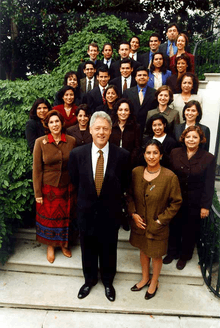
In the 1996 presidential election, 72% of Hispanics and Latinos backed President Bill Clinton. In 2000, the Democratic total fell to 62%, and went down again in 2004, with Democrat John Kerry winning Hispanics 58–40 against Bush.[214] Hispanics in the West, especially in California, were much stronger for the Democratic Party than in Texas and Florida. California Latinos voted 63–32 for Kerry in 2004, and both Arizona and New Mexico Latinos by a smaller 56–43 margin. Texas Latinos were split nearly evenly, favoring Kerry 50–49 over their favorite son candidate, and Florida Latinos (who are mostly Cuban American) backed Bush, by a 54–45 margin.
In the 2006 midterm election, however, due to the unpopularity of the Iraq War, the heated debate concerning illegal Hispanic immigration, and Republican-related Congressional scandals, Hispanics and Latinos went as strongly Democratic as they have since the Clinton years. Exit polls showed the group voting for Democrats by a lopsided 69–30 margin, with Florida Latinos for the first time split evenly.
The runoff election in Texas' 23rd congressional district was seen as a bellwether of Latino politics. Democrat Ciro Rodriguez's unexpected (and unexpectedly decisive) defeat of Republican incumbent Henry Bonilla was seen as proof of a leftward lurch among Latino voters; majority-Latino counties overwhelmingly backed Rodriguez, and majority European-American counties overwhelmingly backed Bonilla.
Elections 2008-2012
| Year | Candidate of the plurality |
Political party |
% of Hispanic vote |
Result |
|---|---|---|---|---|
| 1980 | Jimmy Carter | Democratic | 56% | Lost |
| 1984 | Walter Mondale | Democratic | 61% | Lost |
| 1988 | Michael Dukakis | Democratic | 69% | Lost |
| 1992 | Bill Clinton | Democratic | 61% | Won |
| 1996 | Bill Clinton | Democratic | 72% | Won |
| 2000 | Al Gore | Democratic | 62% | Lost |
| 2004 | John Kerry | Democratic | 58% | Lost |
| 2008 | Barack Obama | Democratic | 67% | Won |
| 2012 | Barack Obama | Democratic | 71% | Won |
| 2016 | Hillary Clinton | Democratic | 65% | Lost |
In the 2008 Presidential election's Democratic primary Hispanics and Latinos participated in larger numbers than before, with Hillary Clinton receiving most of the group's support.[215] Pundits discussed whether Hispanics and Latinos would not vote for Barack Obama because he was African American.[216] Hispanics/Latinos voted 2 to 1 for Mrs. Clinton, even among the younger demographic. In other groups, younger voters went overwhelmingly for Obama.[217] Among Hispanics, 28% said race was involved in their decision, as opposed to 13% for (non-Hispanic) whites.[217] Obama defeated Clinton.
In the matchup between Obama and Republican candidate John McCain, Hispanics and Latinos supported Obama with 59% to McCain's 29% in the June 30 Gallup tracking poll.[218] This was higher than expected, since McCain a had been a leader of the comprehensive immigration reform effort.[219] However, McCain had retreated from reform during the Republican primary, damaging his standing among Hispanics and Latinos.[220] Obama took advantage of the situation by running ads in Spanish highlighting McCain's reversal.[221]
In the general election, 67% of Hispanics and Latinos voted for Obama.[222][223] with a relatively strong turnout in states such as Colorado, New Mexico, Nevada and Virginia, helping Obama carry those formerly Republican states. Obama won 70% of non-Cuban Hispanics and 35% of the traditionally Republican Cuban Americans who have a strong presence in Florida. The relative growth of non-Cuban vs Cuban Hispanics also contributed to his carrying Florida's Latinos with 57% of the vote.[222][224]
While employment and the economy were top concerns for Hispanics and Latinos, almost 90% of Latino voters rated immigration as "somewhat important" or "very important" in a poll taken after the election.[225] Republican opposition to the Comprehensive Immigration Reform Act of 2007 had damaged the party's appeal to Hispanics and Latinos, especially in swing states such as Florida, Nevada, and New Mexico.[225] In a Gallup poll of Hispanic voters taken in the final days of June 2008, only 18% of participants identified as Republicans.[218]
Hispanic and Latinos voted even more heavily for Democrats in the 2012 election with the Democratic incumbent Barack Obama receiving 71% and the Republican challenger Mitt Romney receiving about 27% of the vote.[226][227]
Elections 2014–present

"More convincing data" from the 2016 United States presidential election[228] from the polling firm Latino Decisions indicates that Clinton received a higher share of the Hispanic vote, and Trump a lower share, than the Edison exit polls showed. Using wider, more geographically and linguistically representative sampling, Latino Decisions concluded that Clinton won 79% of Hispanic voters (also an improvement over Obama's share in 2008 and 2012), while Trump won only 18% (lower than previous Republicans such as Romney and McCain).[229] Additionally, the 2016 Cooperative Congressional Election Study found that Clinton's share of the Hispanic vote was one percentage point higher than Obama's in 2012, while Trump's was seven percentage points lower than Romney's.[230]
On June 26, 2018, Alexandria Ocasio-Cortez, a millennial, won the Democratic primary in New York's 14th congressional district covering parts of The Bronx and Queens in New York City, defeating the incumbent, Democratic Caucus Chair Joe Crowley, in what has been described as the biggest upset victory in the 2018 midterm election season and at the age of 29 years, became the youngest woman ever elected to Congress.[231].[232] She is a member of the Democratic Socialists of America and has been endorsed by various politically progressive organizations and individuals.[233]
Notable contributions
Hispanic and Latino Americans have made distinguished contributions to the United States in all major fields, such as politics, the military, music, film, literature, sports, business and finance, and science.[234]
Arts and entertainment
In 1995, the American Latino Media Arts Award, or ALMA Award was created. It's a distinction given to Latino performers (actors, film and television directors, and musicians) by the National Council of La Raza.
Music
There are many Hispanic American musicians that have achieved international fame, such as Christopher Rios better known by his stage name Big Pun, Jennifer Lopez, Joan Baez, Selena Gomez, Demi Lovato, Fergie, Pitbull, Elvis Crespo, Victoria Justice, Linda Ronstadt, Zack de la Rocha, Gloria Estefan, Celia Cruz, Tito Puente, Kat DeLuna, Selena, Ricky Martin, Marc Anthony, Carlos Santana, Christina Aguilera, Bruno Mars, Mariah Carey, Jerry García, Dave Navarro, Santaye, Romeo Santos, Tom Araya, Becky G, Juan Luis Guerra, Cardi B, Giselle Bellas, Bad Bunny, all of the members of all-female band Go Betty Go, and two members of girl group Fifth Harmony: Lauren Jauregui and Ally Brooke.
Latin American music imported from Cuba (chachachá, mambo, and rhumba) and Mexico (ranchera and mariachi) had brief periods of popularity during the 1950s. Examples of artists include Celia Cruz, who was a Cuban-American singer and the most popular Latin artist of the 20th century, gaining twenty-three gold albums during her career. Bill Clinton awarded her the National Medal of Arts in 1994.
Among the Hispanic American musicians who were pioneers in the early stages of rock and roll were Ritchie Valens, who scored several hits, most notably "La Bamba" and Herman Santiago, who wrote the lyrics to the iconic rock and roll song "Why Do Fools Fall in Love". Songs that became popular in the United States and are heard during the holiday/Christmas season include "¿Dónde Está Santa Claus?", a novelty Christmas song with 12-year-old Augie Ríos which was a hit record in 1959 and featured the Mark Jeffrey Orchestra; and "Feliz Navidad" by José Feliciano. Miguel del Aguila wrote 116 works and has three Latin Grammy nominations.
In 1986, Billboard magazine introduced the Hot Latin Songs chart which ranks the best-performing songs on Spanish-language radio stations in the United States. Seven years later, Billboard initiated the Top Latin Albums which ranks top-selling Latin albums in the United States.[235] Similarly, the Recording Industry Association of America incorporated "Los Premios de Oro y Platino" (The Gold and Platinum Awards) to certify Latin recordings which contains at least 50% of its content recorded in Spanish.[236]
In 1989, Univision established the Lo Nuestro Awards which became the first award ceremony to recognize the most talented performers of Spanish-language music and was considered to be the "Hispanic Grammys".[237][238] In 2000, the Latin Academy of Recording Arts & Sciences (LARAS) established the Latin Grammy Awards to recognize musicians who perform in Spanish and Portuguese.[239] Unlike The Recording Academy, LARAS extends its membership internationally to Spanish- and Portuguese-speaking communities worldwide beyond the Americas, particularly into Europe (Iberia).[240]
Film, radio, television, and theatre

.jpg)

Hispanics and Latinos have also contributed some prominent actors and others to the film industry. Of Puerto Rican origin: José Ferrer (the first Hispanic actor to win an acting Academy Award for his role in Cyrano de Bergerac), Auliʻi Cravalho, Rita Moreno, Chita Rivera, Raul Julia, Rosie Perez, Rosario Dawson, Esai Morales, Jennifer Lopez, Joaquin Phoenix, and Benicio del Toro. Of Mexican origin: Emile Kuri (the first Hispanic to win an Academy Award - for Best Production Design - in 1949), Ramon Novarro, Dolores del Río, Lupe Vélez, Anthony Quinn, Ricardo Montalbán, Katy Jurado, Edward James Olmos, Salma Hayek, Danny Trejo, Jessica Alba, Tessa Thompson and Becky G. Of Cuban origin: Cesar Romero, Mel Ferrer, Andy García, Cameron Diaz, María Conchita Alonso, William Levy, and Eva Mendes. Of Dominican origin: Maria Montez and Zoe Saldana. Of Brazilian origin: Carmen Miranda, Sonia Braga, Rodrigo Santoro, Camila Mendes and Jordana Brewster. Of Spanish origin: Rita Hayworth, Martin Sheen and Antonio Banderas. Other outstanding figures are: Anita Page (of Salvadoran origin), Fernando Lamas (of Argentine origin), Raquel Welch (of Bolivian origin, John Leguizamo (of Colombian origin) and Oscar Isaac (of Guatemalan origin).
In stand-up comedy, Paul Rodríguez, Greg Giraldo, Cheech Marin, George Lopez, Freddie Prinze, Jade Esteban Estrada, Carlos Mencia, John Mendoza, Gabriel Iglesias and others are prominent.
Some of the Hispanic or Latino actors who achieved notable success in U.S. television include Desi Arnaz, Lynda Carter, Jimmy Smits, Charo, Selena Gomez, Carlos Pena Jr., Eva Longoria, Sofía Vergara, Benjamin Bratt, Ricardo Montalbán, America Ferrera, Karla Souza, Diego Boneta, Erik Estrada, Cote de Pablo, Freddie Prinze, Lauren Vélez and Charlie Sheen. Kenny Ortega is an Emmy Award-winning producer, director, and choreographer who has choreographed many major television events such as Super Bowl XXX, the 72nd Academy Awards, and Michael Jackson's memorial service.
Hispanics and Latinos are underrepresented in U.S. television, radio, and film. This is combatted by organizations such as the Hispanic Organization of Latin Actors (HOLA), founded in 1975; and National Hispanic Media Coalition (NHMC), founded in 1986.[241] Together with numerous Latino civil rights organizations, the NHMC led a "brownout" of the national television networks in 1999, after discovering that there were no Latinos on any of their new prime time series that year.[242] This resulted in the signing of historic diversity agreements with ABC, CBS, Fox and NBC that have since increased the hiring of Hispanic and Latino talent and other staff in all of the networks.
Latino Public Broadcasting (LPB) funds programs of educational and cultural significance to Hispanic Americans. These programs are distributed to various public television stations throughout the United States.
Fashion
In the world of fashion, notable Hispanic and Latino designers include Oscar de la Renta, Carolina Herrera, Narciso Rodriguez, Manuel Cuevas, among others. Christy Turlington, Gisele Bündchen and Lea T achieved international fame as models.
Artists
Notable Hispanic and Latino artists include Jean-Michel Basquiat, Carmen Herrera, Gronk, Luis Jiménez, Félix González-Torres, Ana Mendieta, Joe Shannon, Richard Serra, Abelardo Morell, Bill Melendez, María Magdalena Campos Pons, Sandra Ramos, Myrna Báez, and Soraida Martinez.
Business and finance

The total number of Hispanic-owned businesses in 2002 was 1.6 million, having grown at triple the national rate for the preceding five years.[51]
Hispanic and Latino business leaders include Cuban immigrant Roberto Goizueta, who rose to head of The Coca-Cola Company.[243] Advertising Mexican-American magnate Arte Moreno became the first Hispanic to own a major league team in the United States when he purchased the Los Angeles Angels baseball club.[244] Also a major sports team owner is Mexican-American Linda G. Alvarado, president and CEO of Alvarado Construction, Inc. and co-owner of the Colorado Rockies baseball team.
There are several Hispanics on the Forbes 400 list of richest Americans. Alejandro Santo Domingo and his brother Andres Santo Domingo inherited their fathers stake in SABMiller, now merged with Anheuser-Busch InBev. The brothers are ranked #132 and are each worth $4.8bn.[245] Jorge Perez founded and runs The Related Group. He built his career developing and operating low-income multifamily apartments across Miami.[246][247] He is ranked #264 and is worth $3bn.[245]
The largest Hispanic-owned food company in the United States is Goya Foods, because of World War II hero Joseph A. Unanue, the son of the company's founders.[248] Angel Ramos was the founder of Telemundo, Puerto Rico's first television station[249] and now the second largest Spanish-language television network in the United States, with an average viewership over one million in primetime. Samuel A. Ramirez Sr. made Wall Street history by becoming the first Hispanic to launch a successful investment banking firm, Ramirez & Co.[250][251] Nina Tassler is president of CBS Entertainment since September 2004. She is the highest-profile Latina in network television and one of the few executives who has the power to approve the airing or renewal of series.
Government and politics

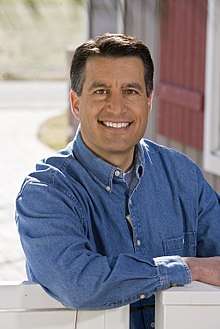
As of 2007, there were more than five thousand elected officeholders in the United States who were of Latino origin.[252]
In the House of Representatives, Hispanic and Latino representatives have included Ladislas Lazaro, Antonio M. Fernández, Henry B. Gonzalez, Kika de la Garza, Herman Badillo, Romualdo Pacheco and Manuel Lujan Jr., out of almost two dozen former Representatives. Current Representatives include Ileana Ros-Lehtinen, Jose E. Serrano, Luis Gutiérrez, Nydia Velázquez, Xavier Becerra, Lucille Roybal-Allard, Loretta Sanchez, Rubén Hinojosa, Mario Díaz-Balart, Raul Grijalva, Ben R. Lujan, Jaime Herrera Beutler, Raul Labrador and Alex Mooney—in all, they number thirty. Former senators are Octaviano Ambrosio Larrazolo, Mel Martinez, Dennis Chavez, Joseph Montoya and Ken Salazar. As of January 2011, the U.S. Senate includes Hispanic members Bob Menendez, a Democrat, and Republicans Ted Cruz and Marco Rubio, all Cuban Americans.[253]
Numerous Hispanics and Latinos hold elective and appointed office in state and local government throughout the United States.[254] Current Hispanic Governors include Republican Nevada Governor Brian Sandoval and Republican New Mexico Governor Susana Martinez; upon taking office in 2011, Martinez became the first Latina governor in the history of the United States.[255] Former Hispanic governors include Democrats Jerry Apodaca, Raul Hector Castro, and Bill Richardson, as well as Republicans Octaviano Ambrosio Larrazolo, Romualdo Pacheco and Bob Martinez.
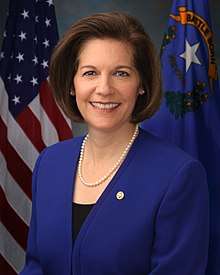
Since 1988,[256] when Ronald Reagan appointed Lauro Cavazos the Secretary of Education, the first Hispanic United States Cabinet member, Hispanic Americans have had an increasing presence in presidential administrations. Hispanics serving in subsequent cabinets include Ken Salazar, current Secretary of the Interior; Hilda Solis, current United States Secretary of Labor; Alberto Gonzales, former United States Attorney General; Carlos Gutierrez, Secretary of Commerce; Federico Peña, former Secretary of Energy; Henry Cisneros, former Secretary of Housing and Urban Development; Manuel Lujan Jr., former Secretary of the Interior; and Bill Richardson, former Secretary of Energy and Ambassador to the United Nations. Rosa Rios is the current US Treasurer, including the latest three, were Hispanic women.
In 2009, Sonia Sotomayor became the first Supreme Court Associate Justice of Hispanic or Latino origin.
The Congressional Hispanic Caucus (CHC), founded in December 1976, and the Congressional Hispanic Conference (CHC), founded on March 19, 2003, are two organizations that promote policy of importance to Americans of Hispanic descent. They are divided into the two major American political parties: The Congressional Hispanic Caucus is composed entirely of Democratic representatives, whereas the Congressional Hispanic Conference is composed entirely of Republican representatives.
Groups like the United States Hispanic Leadership Institute (USHLI) work to achieve the promises and principles of the United States by "promoting education, research, and leadership development, and empowering Latinos and similarly disenfranchised groups by maximizing their civic awareness, engagement, and participation."[257]
Literature and journalism
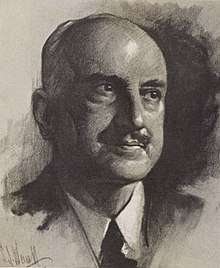

Writers and their works
- Julia Álvarez (How the García Girls Lost Their Accents)
- Rudolfo Anaya (Bless Me, Ultima and Heart of Aztlan)
- Giannina Braschi (Empire of Dreams, Yo-Yo Boing!, and United States of Banana)
- Sandra Cisneros (The House on Mango Street and Woman Hollering Creek and Other Stories)
- Junot Díaz (The Brief Wondrous Life of Oscar Wao)
- Ernest Fenollosa (art historian, Masters of Ukiyoe)
- Rigoberto González (Butterfly Boy: Memories of a Chicano Mariposa)
- Oscar Hijuelos (The Mambo Kings Play Songs of Love)
- Jorge Majfud (Crisis)
- Micol Ostow ("Mind Your Manners, Dick and Jane", "Emily Goldberg Learns to Salsa")[258]
- Benito Pastoriza Iyodo (A Matter of Men and September Elegies)
- Alberto Alvaro Rios (Capirotada, Elk Heads on the Wall and The Iguana Killer)
- Tomas Rivera (...And the Earth did Not Devour Him)
- Richard Rodríguez (Hunger of Memory)
- George Santayana (novelist and philosopher: "Those who cannot remember the past are condemned to repeat it")
- Sergio Troncoso (From This Wicked Patch of Dust and The Last Tortilla and Other Stories)
- Alisa Valdes-Rodriguez (Haters)
- Victor Villaseñor (Rain of Gold)
- Oscar Zeta Acosta (The Revolt of the Cockroach People)
Journalists
- Jorge Ramos has won eight Emmy Awards and the Maria Moors Cabot Award for excellence in journalism. In 2015, Ramos was one of five selected as Time magazine's World's Most Influential People.
- Natalie Morales is the Today Show West Coast anchor and appears on other programs including Dateline NBC and NBC Nightly News.
- Geraldo Rivera has won an Peabody Award and appears regularly on Fox News programs such as The Five.
- John Quiñones co-anchor of the ABC News program, Primetime and now hosts What Would You Do?
- Rubén Salazar reporter for the Los Angeles Times and news director for KMEX, which was a Spanish language station
- Michele Ruiz former Los Angeles news anchor for KNBC-TV.
- Giselle Fernández reporting and guest anchoring for CBS Early Show, CBS Evening News, NBC Today, NBC Nightly News, regular host for Access Hollywood
- Geovanny Vicente, political strategist, international consultant and columnist who writes for CNN.
Military
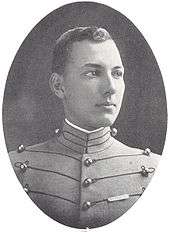
Hispanics and Latinos have participated in the military of the United States and in every major military conflict from the American Revolution onward.[259][260][261] 11% to 13% military personnel now are Latinos and they have been deployed in the Iraq War, the Afghanistan War, and U.S. military missions and bases elsewhere.[262] Hispanics and Latinos have not only distinguished themselves in the battlefields but also reached the high echelons of the military, serving their country in sensitive leadership positions on domestic and foreign posts. Up to now, 43 Hispanics and Latinos have been awarded the nation's highest military distinction, the Medal of Honor (also known as the Congressional Medal of Honor). The following is a list of some notable Hispanics/Latinos in the military:
American Revolution
- Bernardo de Gálvez (1746–1786) – Spanish military leader and colonial administrator who aided the American Thirteen Colonies in their quest for independence and led Spanish forces against Britain in the Revolutionary War; since 2014, a posthumous honorary citizen of the United States
- Lieutenant Jorge Farragut Mesquida (1755–1817) – participated in the American Revolution as a lieutenant in the South Carolina Navy
American Civil War

HstMilitOccNM.jpg)
- Admiral David Farragut – promoted to vice admiral on December 21, 1864, and to full admiral on July 25, 1866, after the war, thereby becoming the first person to be named full admiral in the Navy's history.[263][264]
- Colonel Ambrosio José Gonzales – active during the bombardment of Fort Sumter; because of his actions, was appointed Colonel of artillery and assigned to duty as Chief of Artillery in the department of South Carolina, Georgia and Florida
- Brigadier General Diego Archuleta (1814–1884) – member of the Mexican Army who fought against the United States in the Mexican–American War. During the American Civil War, he joined the Union Army (US Army) and became the first Hispanic to reach the military rank of Brigadier General. He commanded The First New Mexico Volunteer Infantry in the Battle of Valverde. He was later appointed an Indian (Native Americans) Agent by Abraham Lincoln.[265]
- Colonel Carlos de la Mesa – grandfather of Major General Terry de la Mesa Allen Sr. commanding general of the First Infantry Division in North Africa and Sicily, and later the commander of the 104th Infantry Division during World War II. Colonel Carlos de la Mesa was a Spanish national who fought at Gettysburg for the Union Army in the Spanish Company of the "Garibaldi Guard" of the 39th New York State Volunteers.[266]
- Colonel Federico Fernández Cavada – commanded the 114th Pennsylvania Volunteer infantry regiment when it took the field in the Peach Orchard at Gettysburg[267]
- Colonel Miguel E. Pino – commanded the 2nd Regiment of New Mexico Volunteers, which fought at the Battle of Valverde in February and the Battle of Glorieta Pass and helped defeat the attempted invasion of New Mexico by the Confederate Army[268]
- Colonel Santos Benavides – commanded his own regiment, the "Benavides Regiment"; highest ranking Mexican-American in the Confederate Army[267]
- Major Salvador Vallejo – officer in one of the California units that served with the Union Army in the West[268]
- Captain Adolfo Fernández Cavada – served in the 114th Pennsylvania Volunteers at Gettysburg with his brother, Colonel Federico Fernandez Cavada; served with distinction in the Army of the Potomac from Fredericksburg to Gettysburg; "special aide-de-camp" to General Andrew A. Humphreys[267][269]
- Captain Roman Anthony Baca – member of the Union forces in the New Mexico Volunteers; spy for the Union Army in Texas[268]
- Lieutenant Augusto Rodriguez – Puerto Rican native; officer in the 15th Connecticut Volunteer Infantry, of the Union Army; served in the defenses of Washington, D.C. and led his men in the Battles of Fredericksburg and Wyse Fork[270]
- Lola Sánchez – Cuban born woman who became a Confederate spy; helped the Confederates obtain a victory against the Union Forces in the "Battle of Horse Landing"
- Loreta Janeta Velázquez, also known as "Lieutenant Harry Buford" – Cuban woman who donned Confederate garb and served as a Confederate officer and spy during the American Civil War
World War I
- Major General Luis R. Esteves, United States Army – in 1915, became the first Hispanic to graduate from the United States Military Academy ("West Point"); organized the Puerto Rican National Guard
- Private Marcelino Serna – undocumented Mexican immigrant who joined the United States Army and became the most decorated soldier from Texas in World War I; first Hispanic to be awarded the Distinguished Service Cross
World War II
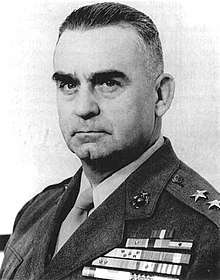

- Lieutenant General Pedro del Valle – first Hispanic to reach the rank of Lieutenant General; played an instrumental role in the seizure of Guadalcanal and Okinawa as Commanding General of the U.S. 1st Marine Division during World War II
- Lieutenant General Elwood R. Quesada (1904–1993) – commanding general of the 9th Fighter Command, where he established advanced headquarters on the Normandy beachhead on D-Day plus one, and directed his planes in aerial cover and air support for the Allied invasion of the European continent during World War II. He was the foremost proponent of "the inherent flexibility of air power", a principle he helped prove during the war.
- Major General Terry de la Mesa Allen Sr. (1888–1969) – commanding general of the 1st Infantry Division in North Africa and Sicily during World War II; commander of the 104th Infantry Division
- Colonel Virgil R. Miller – Regimental Commander of the 442d Regimental Combat Team, a unit composed of "Nisei" (second generation Americans of Japanese descent), during World War II; led the 442nd in its rescue of the Lost Texas Battalion of the 36th Infantry Division, in the forests of the Vosges Mountains in northeastern France[271][272]
- Captain Marion Frederic Ramírez de Arellano (1913–1980) – served in World War II; first Hispanic submarine commander
- First Lieutenant Oscar Francis Perdomo – of the 464th Fighter Squadron, 507th Fighter Group; the last "Ace in a Day" for the United States in World War II
- CWO2 Joseph B. Aviles Sr. – member of the United States Coast Guard; first Hispanic-American to be promoted to Chief Petty Officer; received a war-time promotion to Chief Warrant Officer (November 27, 1944), thus becoming the first Hispanic American to reach that level as well[273]
- Sergeant First Class Agustín Ramos Calero – most decorated Hispanic soldier in the European Theatre of World War II
- PFC Guy Gabaldon, United States Marine Corps – captured over a thousand prisoners during the World War II Battle of Saipan
- Tech4 Carmen Contreras-Bozak – first Hispanic woman to serve in the United States Women's Army Corps, where she served as an interpreter and in numerous administrative positions[274]
Korean War
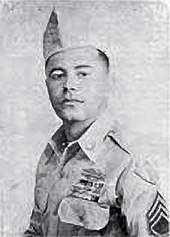
- Major General Salvador E. Felices, United States Air Force – flew in 19 combat missions over North Korea during the Korean War in 1953. In 1957, he participated in "Operation Power Flite", a historic project that was given to the Fifteenth Air Force by the Strategic Air Command headquarters. Operation Power Flite was the first around the world non-stop flight by an all-jet aircraft.
- First Lieutenant Baldomero Lopez – the only Hispanic graduate of the United States Naval Academy ("Annapolis") to be awarded the Medal of Honor
- Sergeant First Class Modesto Cartagena – member of the 65th Infantry Regiment, an all-Puerto Rican regiment also known as "The Borinqueneers", during World War II and the Korean War; most decorated Puerto Rican soldier in history[275]
Cuban Missile Crisis
- Admiral Horacio Rivero, Jr. – second Hispanic four-star admiral; commander of the American fleet sent by President John F. Kennedy to set up a quarantine (blockade) of the Soviet ships during the Cuban Missile Crisis
Vietnam War
- Sergeant First Class Jorge Otero Barreto a.k.a. "The Puerto Rican Rambo"– the most decorated Hispanic American soldier in the Vietnam War[276]
After Vietnam
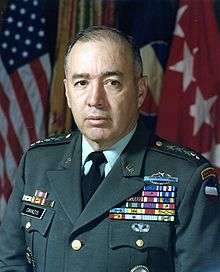

- Lieutenant General Ricardo Sanchez – top commander of the Coalition forces during the first year of the occupation of Iraq, 2003–2004, during the Iraq War
- Lieutenant General Edward D. Baca – in 1994, became the first Hispanic Chief of the National Guard Bureau
- Vice Admiral Antonia Novello, M.D., Public Health Service Commissioned Corps – in 1990, became the first Hispanic (and first female) U.S. Surgeon General
- Vice Admiral Richard Carmona, M.D., Public Health Service Commissioned Corps – served as the 17th Surgeon General of the United States, under President George W. Bush
- Brigadier General Joseph V. Medina, USMC – made history by becoming the first Marine Corps officer to take command of a naval flotilla
- Rear Admiral Ronald J. Rábago – first person of Hispanic American descent to be promoted to rear admiral (lower half) in the United States Coast Guard[277]
- Captain Linda Garcia Cubero, United States Air Force – in 1980, became the first Hispanic woman graduate of the United States Air Force
- Major General Erneido Oliva – Deputy Commanding General of the D.C. National Guard
- Brigadier General Carmelita Vigil-Schimmenti, United States Air Force – in 1985 became the first Hispanic female to attain the rank of Brigadier General in the Air Force[278][279]
- Brigadier General Angela Salinas – on August 2, 2006, became the first Hispanic female to obtain a general rank in the Marines[280]
- Chief Master Sergeant Ramón Colón-López – pararescueman; in 2007, was the only Hispanic among the first six airmen to be awarded the newly created Air Force Combat Action Medal
- Specialist Hilda Clayton (1991–2013) – combat photographer with 55th Signal Company who captured the explosion that killed her and four Afghan soldiers.[281]
Medal of Honor
The following 43 Hispanics were awarded the Medal of Honor: Philip Bazaar, Joseph H. De Castro, John Ortega, France Silva, David B. Barkley, Lucian Adams, Rudolph B. Davila, Marcario Garcia, Harold Gonsalves, David M. Gonzales, Silvestre S. Herrera, Jose M. Lopez, Joe P. Martinez, Manuel Perez Jr., Cleto L. Rodriguez, Alejandro R. Ruiz, Jose F. Valdez, Ysmael R. Villegas, Fernando Luis García, Edward Gomez, Ambrosio Guillen, Rodolfo P. Hernandez, Baldomero Lopez, Benito Martinez, Eugene Arnold Obregon, Joseph C. Rodriguez, John P. Baca, Roy P. Benavidez, Emilio A. De La Garza, Ralph E. Dias, Daniel Fernandez, Alfredo Cantu "Freddy" Gonzalez, Jose Francisco Jimenez, Miguel Keith, Carlos James Lozada, Alfred V. Rascon, Louis R. Rocco, Euripides Rubio, Hector Santiago-Colon, Elmelindo Rodrigues Smith, Jay R. Vargas, Humbert Roque Versace and Maximo Yabes.
National intelligence
- In the spy arena, José Rodríguez, a native of Puerto Rico, was the Deputy Director of Operations and subsequently Director of the National Clandestine Service (D/NCS), two senior positions in the Central Intelligence Agency (CIA), between 2004 and 2007.[282]
- Lieutenant Colonel Mercedes O. Cubria (1903–1980), a.k.a. La Tía (The Aunt), was the first Cuban-born female officer in the United States Army. She served in the Women's Army Corps during World War II and in the United States Army during the Korean War, and was recalled into service during the Cuban Missile Crisis. In 1988, she was posthumously inducted into the Military Intelligence Hall of Fame.[283]
Science and technology
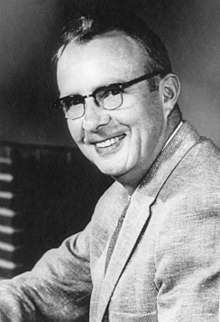
.jpg)
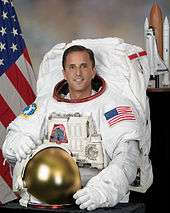

Among Hispanic Americans who have excelled in science are Luis Walter Álvarez, Nobel Prize–winning physicist, and his son Walter Alvarez, a geologist. They first proposed that an asteroid impact on the Yucatán Peninsula caused the extinction of the dinosaurs. Mario J. Molina won the Nobel Prize in chemistry and currently works in the chemistry department at the University of California, San Diego. Dr. Victor Manuel Blanco is an astronomer who in 1959 discovered "Blanco 1", a galactic cluster.[284] F. J. Duarte is a laser physicist and author; he received the Engineering Excellence Award from the prestigious Optical Society of America for the invention of the N-slit laser interferometer.[285] Alfredo Quiñones-Hinojosa is the Director of the Pituitary Surgery Program at Johns Hopkins Hospital and the Director of the Brain Tumor Stem Cell Laboratory at Johns Hopkins School of Medicine. Physicist Albert Baez made important contributions to the early development of X-ray microscopes and later X-ray telescopes. His nephew John Carlos Baez is also a noted mathematical physicist. Francisco J. Ayala is a biologist and philosopher, former president of the American Association for the Advancement of Science, and has been awarded the National Medal of Science and the Templeton Prize. Peruvian-American biophysicist Carlos Bustamante has been named a Searle Scholar and Alfred P. Sloan Foundation Fellow. Luis von Ahn is one of the pioneers of crowdsourcing and the founder of the companies reCAPTCHA and Duolingo. Colombian-American Ana Maria Rey received a MacArthur Fellowship for her work in atomic physics in 2013.
Dr. Fernando E. Rodríguez Vargas discovered the bacteria that cause dental cavity. Dr. Gualberto Ruaño is a biotechnology pioneer in the field of personalized medicine and the inventor of molecular diagnostic systems, Coupled Amplification and Sequencing (CAS) System, used worldwide for the management of viral diseases.[286] Fermín Tangüis was an agriculturist and scientist who developed the Tangüis Cotton in Peru and saved that nation's cotton industry.[287] Severo Ochoa, born in Spain, was a co-winner of the 1959 Nobel Prize in Physiology or Medicine. Dr. Sarah Stewart, a Mexican-American Microbiologist, is credited with the discovery of the Polyomavirus and successfully demonstrating that cancer causing viruses could be transmitted from animal to animal. Mexican-American psychiatrist Dr. Nora Volkow, whose brain imaging studies helped characterize the mechanisms of drug addiction, is the current director of the National Institute on Drug Abuse. Dr. Helen Rodríguez Trías, an early advocate for women's reproductive rights, helped drive and draft U.S. federal sterilization guidelines in 1979. She was awarded the Presidential Citizens Medal by President Bill Clinton, and was the first Latina president of the American Public Health Association.
Some Hispanics and Latinos have made their names in astronautics, including several NASA astronauts:[288] Franklin Chang-Diaz, the first Latin American NASA astronaut, is co-recordholder for the most flights in outer space, and is the leading researcher on the plasma engine for rockets; France A. Córdova, former NASA chief scientist; Juan R. Cruz, NASA aerospace engineer; Lieutenant Carlos I. Noriega, NASA mission specialist and computer scientist; Dr. Orlando Figueroa, mechanical engineer and Director of Mars Exploration in NASA; Amri Hernández-Pellerano, engineer who designs, builds and tests the electronics that will regulate the solar array power in order to charge the spacecraft battery and distribute power to the different loads or users inside various spacecraft at NASA's Goddard Space Flight Center.
Olga D. González-Sanabria won an R&D 100 Award for her role in the development of the "Long Cycle-Life Nickel-Hydrogen Batteries" which help enable the International Space Station power system. Mercedes Reaves, research engineer and scientist who is responsible for the design of a viable full-scale solar sail and the development and testing of a scale model solar sail at NASA Langley Research Center. Dr. Pedro Rodríguez, inventor and mechanical engineer who is the director of a test laboratory at NASA and of a portable, battery-operated lift seat for people suffering from knee arthritis. Dr. Felix Soto Toro, electrical engineer and astronaut applicant who developed the Advanced Payload Transfer Measurement System (ASPTMS) (Electronic 3D measuring system); Ellen Ochoa, a pioneer of spacecraft technology and astronaut; Joseph Acaba, Fernando Caldeiro, Sidney Gutierrez, José M. Hernández, Michael López-Alegría, John Olivas, and George Zamka, who are current or former astronauts.
Sports
Baseball
Latinos have played in the Major Leagues since the very beginning of organized baseball, with Cuban player Esteban Bellán being the first (1873).[289][290] The large number of Hispanic and Latino American stars in Major League Baseball (MLB) includes players like Ted Williams (considered by many to be the greatest hitter of all time), Sammy Sosa, Alex Rodriguez, Alex Rios, Miguel Cabrera, Lefty Gómez, Adolfo Luque, Iván Rodríguez, Carlos González, Roberto Clemente, Adrián González, Jose Fernandez, David Ortiz, Juan Marichal, Fernando Valenzuela, Nomar Garciaparra, Albert Pujols, Omar Vizquel, managers Miguel Angel Gonzalez (the first Latino Major League manager),[291][292] Al López, Ozzie Guillén and Felipe Alou, and General Manager Omar Minaya. Latinos in the MLB Hall of Fame include Roberto Alomar, Luis Aparicio, Rod Carew, Orlando Cepeda, Juan Marichal, Pedro Martínez, Tony Pérez, Iván Rodríguez, Ted Williams, Reggie Jackson, Mariano Rivera, Edgar Martinez, and Roberto Clemente. Afro-Latino players Martín Dihigo, José Mendéz and Cristóbal Torriente are Latino Hall of Famers who played in the Negro Leagues.[293]
Football and basketball

There have been far fewer football and basketball players, let alone star players, but Tom Flores was the first Hispanic head coach and the first Hispanic quarterback in American professional football, and won Super Bowls as a player, as assistant coach and as head coach for the Oakland Raiders. Anthony Múñoz is enshrined in the Pro Football Hall of Fame, ranked #17 on Sporting News's 1999 list of the 100 greatest football players, and was the highest-ranked offensive lineman. Jim Plunkett won the Heisman Trophy and was inducted into the College Football Hall of Fame, and Joe Kapp is inducted into the Canadian Football Hall of Fame and College Football Hall of Fame. Steve Van Buren, Martin Gramatica, Victor Cruz, Tony Gonzalez, Ted Hendricks, Marc Bulger, Tony Romo and Mark Sanchez can also be cited among successful Hispanics and Latinos in the National Football League (NFL).

Trevor Ariza, Mark Aguirre, Carmelo Anthony, Manu Ginóbili, Carlos Arroyo, Gilbert Arenas, Rolando Blackman, Pau Gasol, Jose Calderon, José Juan Barea and Charlie Villanueva can be cited in the National Basketball Association (NBA). Dick Versace made history when he became the first person of Hispanic heritage to coach an NBA team. Rebecca Lobo was a major star and champion of collegiate (National Collegiate Athletic Association (NCAA)) and Olympic basketball and played professionally in the Women's National Basketball Association (WNBA). Diana Taurasi became just the seventh player ever to win an NCAA title, a WNBA title, and as well an Olympic gold medal. Orlando Antigua became in 1995 the first Hispanic and the first non-black in 52 years to play for the Harlem Globetrotters.
Tennis
Tennis players includes legend Pancho Gonzales and Olympic tennis champions and professional players Mary Joe Fernández and Gigi Fernández and 2016 Puerto Rican Gold Medalist Monica Puig.[294]
Soccer
.jpg)
Hispanics are present in all major American sports and leagues, but have particularly influenced the growth in popularity of soccer in the United States. Soccer is the most popular sport across Latin America and Spain, and Hispanics brought the heritage of soccer playing to the United States. Major League Soccer teams such as Chivas USA, LA Galaxy, and the Houston Dynamo, for example, have a fanbase composed primarily of Mexican Americans.[295][296][297] Association football players in the Major League Soccer (MLS) includes several like Tab Ramos, Claudio Reyna, Omar Gonzalez, Marcelo Balboa and Carlos Bocanegra.
Swimming
Swimmers Ryan Lochte (the second-most decorated swimmer in Olympic history measured by total number of medals)[298] and Dara Torres (one of three women with the most Olympic women's swimming medals), both of Cuban ancestry,[299] have won multiple medals at various Olympic Games over the years. Torres is also the first American swimmer to appear in five Olympic Games.[300] Maya DiRado, of Argentine ancestry, won four medals at the 2016 games, including two gold medals.[294]
Other sports
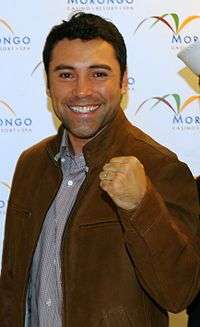
Boxing's first Hispanic American world champion was Solly Smith. Some other champions include Oscar De La Hoya, Miguel Cotto, Bobby Chacon, Brandon Ríos, Michael Carbajal, John Ruiz, Andy Ruiz Jr., and Mikey Garcia.
Ricco Rodriguez, Tito Ortiz, Diego Sanchez, Nick Diaz, Nate Diaz, Dominick Cruz, Frank Shamrock, Gilbert Melendez, Roger Huerta, Carlos Condit, Kelvin Gastelum, Henry Cejudo, and UFC Heavy Weight Champion Cain Velasquez have been competitors in the Ultimate Fighting Championship (UFC) of mixed martial arts.
In 1991, Bill Guerin whose mother is Nicaraguan became the first Hispanic player in the National Hockey League (NHL). He was also selected to four NHL All-Star Games. In 1999, Scott Gomez won the NHL Rookie of the Year Award.[301]
Figure skater Rudy Galindo; golfers Chi Chi Rodríguez, Nancy López, and Lee Trevino; softball player Lisa Fernández; and Paul Rodríguez Jr., X Games professional skateboarder, are all Hispanic or Latino Americans who have distinguished themselves in their sports.
In gymnastics, Laurie Hernandez, who is of Puerto Rican ancestry, was a gold medalist at the 2016 Games.[294]
In sports entertainment we find the professional wrestlers Hulk Hogan, Alberto Del Rio, Rey Mysterio, Eddie Guerrero, Tyler Black and Melina Pérez, and executive Vickie Guerrero.
Hispanophobia
In countries where the majority of the population is of immigrant descent, such as the United States, opposition to immigration sometimes takes the form of nativism.[302] Throughout U.S. history, Hispanophobia has existed to varying degrees, and it was largely based on ethnicity, race, culture, Anti-Catholicism, economic and social conditions in Latin America, and use of the Spanish language.[303][304][305][306] In 2006, Time Magazine reported that the number of hate groups in the United States increased by 33 percent since 2000, primarily due to anti-illegal immigrant and anti-Mexican sentiment.[307] According to Federal Bureau of Investigation (FBI) statistics, the number of anti-Latino hate crimes increased by 35 percent since 2003 (albeit from a low level). In California, the state with the largest Latino population, the number of hate crimes against Latinos almost doubled.[308]
In the year 2009, the FBI reported that 483 of the 6,604 hate crimes which were recorded in the United States were anti-Hispanic, comprising 7.3% of all recorded hate crimes, the lowest percentage of all of the hate crimes which were recorded in 2009. This percentage is contrasted by the fact that 34.6% of all of the hate crimes which were recorded in 2009 were anti-Black, 17.9% of them were anti-homosexual, 14.1% of them were anti-Jewish, and 8.3% of them were anti-White.[309]
See also
Places of settlement in United States:
- List of U.S. communities with Hispanic-majority populations in the 2010 census
- List of U.S. cities with large Hispanic populations
- List of U.S. cities by Spanish-speaking population
- Hispanics and Latinos in New Jersey
- Hispanics and Latinos in Massachusetts
- Hispanics and Latinos in Washington, D.C.
- Hispanic and Latino Americans in California
- Hispanic and Latino Americans in Arizona
- Hispanic and Latino Americans in New Mexico
- Hispanic and Latino Americans in Texas
- Hispanic and Latino Americans in Nevada
- Hispanic and Latino Americans in Florida
Diaspora:
- Latino diaspora
- Hispanidad
- Latin Americans
- Latin American Asian
- Hispanics and Latins in Europe
Individuals:
- List of Hispanic and Latino Americans
Other Hispanic and Latino Americans topics:
- National Alliance for Hispanic Health
- White Hispanic and Latino Americans
- List of U.S. place names of Spanish origin
- Latino National Survey, 2006
General:
Notes
- As a U.S. Supreme Court Justice, Sotomayor was nominated by Barack Obama and confirmed by the U.S. Senate, not elected.
References
- "B03002 HISPANIC OR LATINO ORIGIN BY RACE - United States - 2018 American Community Survey 1-Year Estimates". U.S. Census Bureau. July 1, 2018. Retrieved November 25, 2019.
- "U.S. Catholic Hispanic Population Less Religious, Shrinking". =Gallup.com. Retrieved March 5, 2015.
- "The Shifting Religious Identity of Latinos in the United States". May 7, 2014.
- "Growing number of Latinos have no religious affiliation". NBC Latino. Retrieved March 5, 2015.
- "Overview of Race and Hispanic Origin: 2010" (PDF). U.S. Census Bureau. March 2011. Archived from the original (PDF) on April 29, 2011. Retrieved January 9, 2016.
- Luis Fraga; John A. Garcia (2010). Latino Lives in America: Making It Home. Temple University Press. p. 145. ISBN 978-1-4399-0050-5.
- Nancy L. Fisher (1996). Cultural and Ethnic Diversity: A Guide for Genetics Professionals. Johns Hopkins University Press. p. 19. ISBN 978-0-8018-5346-3.
- Robert H. Holden; Rina Villars (2012). Contemporary Latin America: 1970 to the Present. John Wiley & Sons. p. 18. ISBN 978-1-118-27487-3.
- "49 CFR Part 26". Retrieved October 22, 2012.
'Hispanic Americans,' which includes Spanish, other European or Middle Eastern-descended persons of Mexican-, Puerto Rican-, Jamaican-, Cuban, Dominican-, Central or South American
- "US Small Business Administration 8(a) Program Standard Operating Procedure" (PDF). Archived from the original (PDF) on September 25, 2006. Retrieved October 22, 2012.
SBA has defined 'Hispanic American' as an individual whose ancestry and culture are rooted in South America, Central America, Cuba, Puerto Rico, the Dominican Republic and Mexico
- Humes, Karen R.; Jones, Nicholas A.; Ramirez, Roberto R. "Overview of Race and Hispanic Origin: 2010" (PDF). U.S. Census Bureau. Archived from the original (PDF) on April 29, 2011. Retrieved March 28, 2011.
"Hispanic or Latino" refers to a person of Cuban, Mexican, Puerto Rican, South or Central American, or other Spanish culture or origin regardless of race.
- "American FactFinder Help: Hispanic or Latino origin". United States Census Bureau. Archived from the original on February 13, 2020. Retrieved October 5, 2008.
- Mark Hugo Lopez, Jens Manuel Krogstad and Jeffrey S. Passel, Who Is Hispanic?, Pew Research Center (November 11, 2019).
- Office of Management and Budget. "Revisions to the Standards for the Classification of Federal Data on Race and Ethnicity. Federal Register Notice October 30, 1997". Archived from the original on January 17, 2017. Retrieved June 1, 2012.
- Grieco, Elizabeth M.; Rachel C. Cassidy. "Overview of Race and Hispanic Origin: 2000" (PDF). United States Census Bureau. Retrieved April 27, 2008.
- "B03001. Hispanic or Latino origin by specific origin". 2009 American Community Survey 1-Year Estimates. U.S. Census Bureau. Retrieved October 17, 2010.
- "CIA – The World Factbook – Field Listing :: Ethnic groups". Retrieved November 18, 2010.
- "T4-2007. Hispanic or Latino By Race [15]". 2007 Population Estimates. United States Census Bureau.
- "B03002. Hispanic or Latino origin by race". 2007 American Community Survey 1-Year Estimates. United States Census Bureau.
- Tafoya, Sonya (December 6, 2004). "Shades of Belonging" (PDF). Pew Hispanic Center. Archived from the original (PDF) on March 3, 2016. Retrieved May 7, 2008.
- The Contested Homeland - A Chicano History of New Mexico
- "Hispanics Were Not The Fastest-Growing Minority Group Last Year". MarketingCharts. July 23, 2013. Retrieved March 5, 2015.
- "Oldest U.S. City — Infoplease.com". Retrieved November 21, 2008.
- The Encyclopedia Americana. Encyclopedia Americana Corp. 1919. p. 151.
- "Documents in Mexican American History". University of Houston. Archived from the original on January 21, 2012. Retrieved June 11, 2008.
- "Cuartocentennial of Colonization of New Mexico". New Mexico State University. Archived from the original on November 15, 2011. Retrieved June 11, 2008.
- "Supplemental Table 2. Persons Obtaining Lawful Permanent Resident Status by Leading Core Based Statistical Areas (CBSAs) of Residence and Region and Country of Birth: Fiscal Year 2014". U.S. Department of Homeland Security. Retrieved July 3, 2017.
- Katarzyna Bryc, Eric Y. Durand, J. Michael Macpherson, David Reich & Joanna L. Mountain, The Genetic Ancestry of African Americans, Latinos, and European Americans across the United States, American Journal of Human Genetics, Vol. 96, Issue 1, pp. 37-53 (2015).
- Ana Gonzales-Barrera & Mark Hugo Lopez, Is being Hispanic a matter of race, ethnicity or both?, Pew Research Center (June 15, 2015).
- United States Census Bureau. "U.S. Census Bureau Guidance on the Presentation and Comparison of Race and Hispanic Origin Data". Retrieved March 18, 2007.
Race and Hispanic origin are two separate concepts in the federal statistical system. People who are Hispanic may be of any race. People in each race group may be either Hispanic or not Hispanic. Each person has two attributes, their race (or races) and whether or not they are Hispanic/Latino.
- Lopez, Mark Hugo (February 19, 2016). "Is speaking Spanish necessary to be Hispanic? Most Hispanics say no". Pew Research Center.
- "Mexican America: Glossary". Smithsonian Institution. Archived from the original on June 21, 2008.
Note: It defines "Hispanic" as meaning those with Spanish-speaking roots in the Americas and Spain, and "Latino" as meaning those from both Spanish- and Portuguese-speaking cultures in Latin America.
- "[T]he term 'Latino' ... may be more inclusive than the term 'Hispanic.'" Deborah A. Ramirez, "Excluded Voices: The Disenfranchisement of Ethnic Groups From Jury Service", 1993 Wis. L. Rev. 761, 806 (1993).
- Carlos Dejud (2007). The Relationship Among Ethnic Identity, Psychological Well-being, Academic Achievement, and Intergroup Competence of School-age Hispanic/Latino Youth. p. 21. ISBN 978-0-549-29853-3.
- Cobos, Rubén (2003) "Introduction," A Dictionary of New Mexico & Southern Colorado Spanish (2nd ed.); Santa Fe: Museum of New Mexico Press; p. ix; ISBN 0-89013-452-9
- "Revisions to the Standards for the Classification of Federal Data on Race and Ethnicity. Federal Register Notice". Office of Management and Budget. The White House. October 30, 1997. Retrieved June 1, 2012.
- "Online Etymology Dictionary". Etymonline.com. Retrieved March 5, 2015.
- Timothy Ready (1991). Latino Immigrant Youth: Passages from Adolescence to Adulthood. Taylor & Francis. p. 14. ISBN 978-0-8153-0057-1.
- "The Effects of Multicultural Dance on Self-Determination of Adults with Intellectual Disabilities". Csuchico-dspace.calstate.edu. September 21, 2010. Retrieved January 16, 2018.
- Anderson, Kevin (October 18, 2008). "The complexity of race in New Mexico". The Guardian. London.
- "AP Stylebook Twitter". Retrieved April 6, 2012.
- "Herald Style Guide". Retrieved April 6, 2012.
- "Newsroom 101: Recent Changes to AP Style". Newsroom 101. Archived from the original on April 18, 2012. Retrieved April 6, 2012.
- ASALE, RAE-. "latinoamericano, na". «Diccionario de la lengua española» - Edición del Tricentenario (in Spanish). Retrieved July 24, 2019.
- ASALE, RAE-. "iberorrománico, ca". «Diccionario de la lengua española» - Edición del Tricentenario (in Spanish). Retrieved July 24, 2019.
- Ramirez, Tanisha Love; Blay, Zeba (July 5, 2016). "Why People Are Using The Term 'Latinx'". HuffPost. Retrieved July 24, 2019.
- Blackwell; McCaughan, ibid., p. 9
- Pero Like (October 14, 2017), What's The Deal With "Latinx"?, retrieved July 24, 2019
- David J. Weber, Spanish Frontier in North America (Yale U.P., 1992) pp 30-91.
- Campbell Gibson; Kay Jung (September 2002). "Historical Census Statistics on Population Totals By Race, 1790 to 1990, and By Hispanic Origin, 1970 to 1990, For The United States, Regions, Divisions, and States" (PDF). Population Division. United States Census Bureau. Archived from the original (PDF) on March 27, 2010.
- "US Census Press Releases; Hispanic Heritage Month 2009: Sept. 15 – Oct. 15". Archived from the original on February 23, 2010. Retrieved January 26, 2010.
- "Hispanic Americans are getting laid off at higher rates May 7". Retrieved May 7, 2020.
- "HISPANIC OR LATINO ORIGIN BY SPECIFIC ORIGIN: 2017 American Community Survey 1-Year Estimates". Factfinder.Census.Gov. United States Census Bureau. 2017. Archived from the original on February 14, 2020. Retrieved September 18, 2018.
- "T1. Population Estimates [10]; Data Set: 2007 Population Estimates". United States Census Bureau. Retrieved April 30, 2008.
- "US Census Press Releases". United States Census Bureau. July 16, 2008. Archived from the original on September 14, 2007. Retrieved April 30, 2008.
- USA Today: "Census: Hispanics surpass blacks in most U.S. metros" April 14, 2011
- "Table 4. Projections of the Population by Sex, Race, and Hispanic Origin for the United States: 2010 to 2050". U.S. Census Bureau. Archived from the original (Excel) on March 27, 2010. Retrieved October 24, 2010.
- "Hispanic Population and Origin in Select U.S. Metropolitan Areas, 2014". Pew Research Center: Hispanic Trends. Pew Research Center. September 6, 2016.
- "Hispanic Population by State: 2006" (PDF). Pew Hispanic Center. Archived from the original (PDF) on May 5, 2008. Retrieved May 7, 2008.
- "HISPANIC OR LATINO ORIGIN BY SPECIFIC ORIGIN: 2018 American Community Survey 1-Year Estimates". United States Census Bureau. 2018.
- "PLACE OF BIRTH (HISPANIC OR LATINO) IN THE UNITED STATES : Hispanic or Latino population in the United States 2017 American Community Survey 1-Year Estimates". Factfinder.Census.Gov. United States Census Bureau. 2017. Archived from the original on February 14, 2020. Retrieved September 18, 2018.
- "New Mexico CultureNet – Cuartocentenario". New Mexico CultureNet. Archived from the original on October 6, 2007. Retrieved May 13, 2008.
- "HISPANIC OR LATINO ORIGIN BY RACE Universe: Total population; 2017 American Community Survey 1-Year Estimates". Factfinder.Census.Gov. United States Census Bureau. 2017. Archived from the original on February 14, 2020. Retrieved September 18, 2018.
- Latina Magazine "A native of Phoenix, Nanette moved with her family at age 8 to Guadalajara (and later to Mexico City), where she developed "a Mexican soul," she says... It's a legacy Alexis feels strongly connected to—and proud of. "In general I think Latinos know how to live and eat and sleep and spend time with their families," she says."
- "A Chat With Alexis Bledel" February 19, 2003, DVDTown.com Archived August 7, 2011, at the Wayback Machine
- "Technical Documentation for the Census 2000 Modified Race Data Summary File". United States Census Bureau. Archived from the original on September 18, 2004.
- "B03002. Hispanic or Latino origin by race". 2007 American Community Survey 1-Year Estimates. United States Census Bureau. while the ratio rises to 92% in the Population Estimates Program, which are the official estimates."T4-2007. Hispanic or Latino By Race [15]". 2007 Population Estimates. United States Census Bureau.
- Aske, Jon. "Hispanics and Race".
- Mara Loveman; Jeronimo Muniz (2006). How Puerto Rico Became White - University of Wisconsin Archived 2012-02-07 at the Wayback Machine.
- Marcheco-Teruel, Beatriz; Parra, Esteban J; Fuentes-Smith, Evelyn; Salas, Antonio; Buttenschøn, Henriette N; Demontis, Ditte; Torres-Español, María; Marín-Padrón, Lilia C; Gómez-Cabezas, Enrique J; Álvarez-Iglesias, Vanesa; Mosquera-Miguel, Ana; Martínez-Fuentes, Antonio; Carracedo, Ángel; Børglum, Anders D; Mors, Ole (2014). "Cuba: Exploring the History of Admixture and the Genetic Basis of Pigmentation Using Autosomal and Uniparental Markers". PLOS Genetics. 10 (7): e1004488. doi:10.1371/journal.pgen.1004488. PMC 4109857. PMID 25058410.
- "Republic of Cuba - Country Profile". nationsonline.org. Retrieved January 10, 2016.
- "The World Factbook". Cia.gov. Retrieved March 5, 2015.
- Carl Zimmer (2014). The New York Times: White? Black? A Murky Distinction Grows Still Murkier.
- Patten, Eileen (2016-04-20). "The Nation's Latino Population Is Defined by Its Youth". Pew Research Center's Hispanic Trends Project. Retrieved 2017-05-17.
- Santiago, D., Galdeano, E. C., & Taylor, M. (2015). The Condition of Latinos in Education: 2015 Factbook. doi:10.1016/S0140-6736(02)77934-8
- Patricia C. Gandara; Frances Contreras (2009). The Latino Education Crisis: The Consequences of Failed Social Policies. Harvard University Press. ISBN 978-0-674-03127-2. Retrieved January 10, 2016.
- Fergus, E (2009). "Understanding Latino Students' Schooling Experiences: The Relevance of Skin Color Among Mexican and Puerto Rican High School Students". Teachers College Record. 111 (2): 339–375.
- Gándara, P (2015). "With the future on the line: Why studying Latino education is so important". American Journal of Education. 121 (3): 451–463. doi:10.1086/680411.
- "Hispanics: Education Issues".
- Becerra, D (2012). "Perceptions of educational barriers affecting the academic achievement of Latino K-12 students". Children and Schools. 34 (3): 167–177. doi:10.1093/cs/cds001.
- "By the Numbers: ACE Report Identifies Educational Barriers for Hispanics".
- Valenzuela, Angela (October 21, 1999). Subtractive Schooling: U.S. - Mexican Youth and the Politics of Caring. SUNY Press. ISBN 9780791443224. Retrieved January 16, 2018 – via Google Books.
- Wojtkiewicz, R. A.; Donato, K. M. (1995). "Hispanic Educational Attainment: The Efects of Family Background and Nativiy". Social Forces. 74 (2): 559–574. doi:10.1093/sf/74.2.559.
- "UTEP Ranked #1 Engineering School for Hispanics for 3rd Consecutive Year". University of Texas at El Paso.
- Castro, Max J. (2002). The Dominican Diaspora Revisited, Dominicans and Dominican-Americans in a New Century.
- "Ivy League Schools Don't Reflect U.S. Minority Ratios". www.nationaljournal.com. Archived from the original on March 18, 2015. Retrieved March 5, 2015.
- "Record Number of African Americans, Latinos Matriculate as Yield Increases". Thecrimson.com. Retrieved March 5, 2015.
- "Stanford University: Common Data Set 2013-2014". Ucomm.stanford.edu. Retrieved March 5, 2015.
- "HACU Lists of Hispanic-Serving Institutions (HSIs) and Emerging HSIs 2017-2018". Hispanic Association of Colleges and Universities. Retrieved April 3, 2019.
- "HO Top 100 Rankings: Colleges & Universities Granting" (PDF). hispanicoutlook.com. May 13, 2013. Archived from the original (PDF) on November 2, 2013. Retrieved January 9, 2016.
- "California Community Colleges Chancellor's Office - Data Mart". Datamart.cccc.edu. Retrieved March 5, 2015.
- Monica Malhotra. "CSU - AS - Enrollment by Ethnic Group - Fall 2013". Calstate.edu. Retrieved March 5, 2015.
- "THE FACT BOOK: Report for the Florida College System 2014" (PDF). Florida Department of Education Division of Accountability, Research, and Measurement. 2014. Archived from the original (PDF) on March 4, 2016. Retrieved January 9, 2016.
- "Facts 2013" (PDF). The University of Texas System. 2013. Archived from the original (PDF) on March 4, 2016. Retrieved January 9, 2016.
- "State University System of Florida - Board of Governors : Resources". Flbog.edu. Retrieved March 5, 2015.
- "A Profile of Undergraduates at CUNY Senior and Community Colleges: Fall 2013" (PDF). CUNY Office of Institutional Research and Assessment. May 14, 2014. Archived from the original (PDF) on February 10, 2016. Retrieved January 9, 2016.
- SUNY. "Fast Facts - SUNY". Suny.edu. Retrieved March 5, 2015.
- "Texas Higher Education Coordinating Board Institutional Targets for Closing the Gaps in Participation, Targets One - Four" (PDF). Texas Higher Education Coordinating Board. February 24, 2014. Retrieved January 9, 2016.
- "The Texas A&M University System Facts 2013" (PDF). www.tamus.edu. 2013. Retrieved January 9, 2016.
- "Nevada System Of Higher Education: Diversity: Minority Status" (PDF). NSHE.
- Elizabeth Arias, Jiaquan Xu & Kenneth D. Kochanek, United States Life Tables, 2016, National Vital Statistics Reports, Vol. 68, No. 4 (May 7, 2019).
- Noreen Goldman, Will the Latino Mortality Advantage Endure?, Research on Aging Vol. 38, Issue 3, April 2016, pp. 263-283.
- Christina J. Diaz, Stephanie M. Koning & Ana P. Martinez-Donate, Moving Beyond Salmon Bias: Mexican Return Migration and Health Selection, Demography (December 2016), Vol. 53, Issue 6, pp. 2005-2030.
- Diaz, Christina J.; Niño, Michael (2019). "Familism and the Hispanic Health Advantage: The Role of Immigrant Status". Journal of Health and Social Behavior. 60 (3): 274–290. doi:10.1177/0022146519869027. PMID 31526018.
- Samantha Artiga, Kendal Orgera & Anthony Damico (February 13, 2019). "Changes in Health Coverage by Race and Ethnicity since Implementation of the ACA, 2013-2017". Kaiser Family Foundation.
- de Leon Siantz, M. L., Castaneda, X., Benavente, V., Peart, T., & Felt, E. (2013). The health status of Latino immigrant women in the United States and future health policy implication of the affordable care act. Global Advances in Health and Medicine, 2(5), 70-74.
- de Leon Siantz, M. L., Castaneda, X., Benavente, V., Peart, T., & Felt, E. (2013). The health status of latino immigrant women in the United States and future health policy implication of the affordable care act. Global Advances in Health and Medicine, 2(5), 70-74.
- Torres, S., A., Santiago, C., D., Walts, K., K., Richards, M., H. (2018). Immigration policy, practices and procedures: the impact on the mental health of Mexican and central American youth and families. American Psychologist, 1-12
- Letiecq, B., L., Grzywacz, J., G., Gray, K., M., Eudave, Y., M.(2014). Depression among Mexican men on the migration frontier: the role of family separation and other structural and situational stressors. Journal of Immigrant and Minority Health, 16, 1193-1200
- Torres, S., A., Santiago, C., D., Walts, K., K., Richards, M., H. (2018). Immigration policy, practices and procedures: the impact on the mental health of Mexican and central American youth and families. American Psychologist, 1-12.
- Quayson, A., Daswani, G. (2013). A Companion to Diaspora and Transnationalism. Hoboken, New Jersey: Wiley-Blackwell Publishing
- Torres, S., A., Santiago, C., D., Walts, K., K., Richards, M., H.(2018). Immigration policy, practices and procedures: the impact on the mental health of Mexican and central American youth and families. American Psychologist, 1-12.
- Hinojos, B. (2013). Stressors and Coping Strategies of Undocumented Latinos in Therapy. Public Access Theses and Dissertations from the College of Education and Human Sciences. Retrieved from: https://digitalcommons.unl.edu/cgi/viewcontent.cgi?article=1189&context=cehsdiss
- Hinojos, B.(2013). Stressors and Coping Strategies of Undocumented Latinos in Therapy. Public Access Theses and Dissertations from the College of Education and Human Sciences. Retrieved from: https://digitalcommons.unl.edu/cgi/viewcontent.cgi?article=1189&context=cehsdiss
- López, Gustavo (September 15, 2015). "The Impact of Slowing Immigration: Foreign-Born Share Falls Among 14 Largest U.S. Hispanic Origin Groups". Pew Research Center. Retrieved September 15, 2015.
- https://census.gov/content/dam/Census/library/publications/2018/demo/p60-263.pdf
- http://www.pewresearch.org/fact-tank/2017/09/18/how-the-u-s-hispanic-population-is-changing/
- Gándara, P (2015). "With the future on the line: Why studying Latino education is so important". American Journal of Education. 121 (3): 454. doi:10.1086/680411.
- "What is the future of Spanish in the United States?". Pew Research Center. September 5, 2013. Retrieved March 5, 2015.
- Hyon B. Shin; Rosalind Bruno (October 2003). "Language Use and English-Speaking Ability: 2000" (PDF). U.S. Census Bureau. Retrieved January 9, 2016.
- "The Future of Spanish in the United States". Languagepolicy.net. Retrieved March 5, 2015.
- Data Access and Dissemination Systems (DADS). "American FactFinder - Results". Factfinder2.census.gov. Archived from the original on February 12, 2020. Retrieved March 5, 2015.
- Cindy Y. Rodriguez, CNN (September 20, 2013). "Fewer Latinos will speak Spanish, more non-Latinos will, report says". Cnn.com. Retrieved March 5, 2015.
- "IV. Language Use". Pew Research Center's Hispanic Trends Project. December 11, 2009. Retrieved March 5, 2015.
- "Languages Spoken and Learned in the United States". Vistawide.com. Retrieved March 5, 2015.
- "Most Studied Foreign Languages in the U.S." Infoplease.com. Retrieved March 5, 2015.
- Small, Lawrence M (August 1, 2002). "Latino Legacies". Smithsonian Magazine. Smithsonian Institution. Retrieved April 28, 2008.
There was a Hispanic presence on the continent for more than 200 years before 13 colonies on the eastern coast declared their independence from England.... By 1607, when the British established their first successful settlement, at Jamestown, Virginia, writes historian Bernard Bailyn, "Spain's American dominion extended nearly 8,000 miles, from Southern California to the Straits of Magellan...
- "A Brief History of St. Augustine". City of St. Augustine. Archived from the original on September 7, 2016. Retrieved April 28, 2008.
Founded in 1565, St. Augustine is the oldest continuously occupied settlement of European origin in the United States. Forty-two years before the English colonized Jamestown and fifty-five years before the Pilgrims landed at Plymouth Rock, the Spanish established at St. Augustine this nation's first enduring settlement.
- "A Spanish Expedition Established St. Augustine in Florida". America's Library. Library of Congress. Archived from the original on May 24, 2008. Retrieved April 28, 2008.
On September 8, 1565, Pedro Menéndez de Avilés landed on the shore of what is now called Matanzas Bay and began the founding of the Presidio of San Agustin. Later the settlement would be called St. Augustine, Florida. Built on the site of an ancient Native American village, and near the place where Ponce de León, the European discoverer of Florida, landed in 1513 in search of the legendary Fountain of Youth, it has been continually inhabited since its founding.
- Francisco Lopez de Mendoza Grajales. "The Founding of St. Augustine, 1565". Modern History Sourcebook. Fordham University. Archived from the original on September 26, 2010. Retrieved April 28, 2008.
- "B16006. Language spoken at home by ability to speak English for the population 5 years and over (Hispanic or Latino)". 2006 American Community Survey. United States Census Bureau. Retrieved June 12, 2008. [There were 39.5 million Hispanic and Latino Americans aged 5 or more in 2006. 8.5 million of them, or 22%, spoke only English at home, and another 156,000, or 0.4%, spoke neither English nor Spanish at home. The other 30.8 million, or 78%, spoke Spanish at home. Of these, 3.7 million spoke no English, while the overwhelming majority, 27.2 million, did, at these levels: 15.5 million "very well", 5.8 million "well", and 5.9 million "not well". These 27.2 million bilingual speakers represented 69% of all (39.5 million) Hispanic and Latino Americans aged five or over in 2006, while the 3.7 million monolingual Spanish-speakers represented 9%.]
- "Spanish is the most spoken non-English language in U.S. homes, even among non-Hispanics". Pew Research Center. August 13, 2013. Retrieved March 5, 2015.
- "United States - Selected Population Profile in the United States (Hispanic or Latino (of any race))". 2006 American Community Survey. United States Census Bureau. Archived from the original on September 2, 2010. Retrieved June 11, 2008.
- "8 Reasons Spanish Isn't A Foreign Language In The U.S. (SLIDESHOW)". The Huffington Post. June 12, 2013. Retrieved March 5, 2015.
- "Do You Speak American . Sea to Shining Sea . American Varieties . Spanglish . Book - PBS". Pbs.org. Retrieved March 5, 2015.
- Patience Haggin. "Miami Accents: Why Locals Embrace That Heavy "L" Or Not". Wlrn.org. Retrieved March 5, 2015.
- In U.S., Decline of Christianity Continues at Rapid Pace, Pew Research Center (October 17, 2019).
- The Shifting Religious Identity of Latinos in the United States, Pew Research Center (May 7, 2014).
- Chapter 7: Renewalism and Hispanic Christianity, The Shifting Religious Identity of Latinos in the United States, Pew Research Center (May 7, 2014).
- Select-a-faith: Latinos are quitting the Catholic church, economist.com.
- "Faith: Pick and mix". The Economist. March 14, 2015. Retrieved March 28, 2015.
- Gaston Espinosa, "Latinos, Religion, and the American Presidency," in Religion, Race, and the American Presidency, ed. Gaston Espinosa (Lanham, Md.: Rowman & Littlefield Publishers), 242-44.
- Elizabeth Dias, U.S. Catholic Bishops Elect Hispanic Immigrant as Leader, New York Times (November 12, 2019).
- J.D. Long-García, The Hispanic Catholic Church in the U.S. is growing, survey confirms, America (May 4, 2018).
- Yann P. Kerevel, "The Influence of Spanish‐Language Media on Latino Public Opinion and Group Consciousness." Social Science Quarterly 92.2 (2011): 509-534. online
- Federico A. Subervi-Ve´lez, "The Mass Media and Ethnic Assimilation and Pluralism: A Review and Research Proposal with Special Focus on Hispanics" Communication Research 13#1:71–96.
- https://www.nbcnews.com/news/latino/ozzie-areu-first-latino-own-major-studio-has-hollywood-story-n1141531
- https://www.gpb.org/news/2019/12/05/atlantas-areu-bros-open-first-latinx-owned-studios-in-us
- Todd Chambers, "The state of Spanish-language radio." Journal of Radio Studies 13.1 (2006): 34-50.
- Jorge Reina Schement, "The Origins of Spanish-Language Radio: The Case of San Antonio, Texas," Journalism History 4:2 (1977): 56-61.
- Félix F. Gutiérrez and Jorge Reina Schement, Spanish-Language Radio in the Southwestern United States (Austin: UT Center for Mexican American Studies, 1979).
- Andrew Paxman, "The Rise of US Spanish-Language Radio From 'Dead Airtime' to Consolidated Ownership (1920s-1970s)." Journalism History 44.3 (2018).
- Dolores Inés Casillas, Sounds of belonging: US Spanish-language radio and public advocacy (NYU Press, 2014).
- "As Hispanic Television Market Grows, Univision Reshuffles Executives - Adweek". AdWeek. Retrieved March 5, 2015.
- "Hispanic influence: Tortillas take over burger buns as fast-food fave". The Washington Times. Retrieved March 5, 2015.
- "Latino, other ethnic influences changing America's food choices". NBC Latino. Retrieved March 5, 2015.
- "Food in United States Latino Americans - Latino American Food, Latino American Cuisine - traditional, popular, dishes, recipe, diet, history, common, meals, rice, famous, main, people, favorite, types, make, customs, fruits, country, bread, vegetables". Foodbycountry.com. Retrieved March 5, 2015.
- Susan Adcox. "Grandparents Important in Hispanic Family Structure". About.com Parenting. Retrieved March 5, 2015.
- "Hispanic Priorities: Marriage, Family and Youth". Hispanics.barna.org. Archived from the original on March 1, 2015. Retrieved March 5, 2015.
- "Cultural Values of Latino Patients and Families". Dimensionsofculture.com. Retrieved March 5, 2015.
- Nancy S. Landale. "Hispanic Families in the United States: Family Structure and Process in an Era of Family Change - Hispanics and the Future of America - NCBI Bookshelf". Ncbi.nlm.nih.gov. Retrieved March 5, 2015.
- "Hispanics Place Higher Emphasis On Education, Poll Reports". The Huffington Post. July 20, 2010. Retrieved March 5, 2015.
- Brown, B. Bradford, Reed W. Larson, and Tharakad Subramanium Saraswathi, eds. The World's Youth: Adolescence in Eight Regions of the Globe. Cambridge University Press, 2002.
- Pew Social Trends: "Marrying Out" Archived 2016-06-11 at the Wayback Machine June 15, 2010
- Pew Research Social & Demographic Trends: "The Rise of Intermarriage - Rates, Characteristics Vary by Race and Gender" by Wendy Wang February 16, 2012
- Sharon M. Lee; Barry Edmonston (June 2005). "New Marriages, New Families: U.S. Racial and Hispanic Intermarriage" (PDF). Population Reference Bureau Population Bulletin. 6 (2). ISSN 0032-468X. Archived from the original (PDF) on March 3, 2016. Retrieved January 9, 2016.
- Jeffrey S. Passel; Wendy Wang; Paul Taylor (June 4, 2010). "Marrying Out: One-in-Seven New U.S. Marriages is Interracial or Interethnic" (PDF). Pew Research Center. Archived from the original (PDF) on January 31, 2016. Retrieved January 9, 2016.
- Glazer, Nathan (1998). We are All Multiculturalists Now. p. 129. ISBN 9780674948365. Retrieved March 5, 2015.
- "Multiracial population Orlando grows: Multiracial population grows in Orlando". Orlando Sentinel. Retrieved March 5, 2015.
- "How interracial relationships shape the Latino community". Being Latino Online Magazine. Archived from the original on November 2, 2014. Retrieved March 5, 2015.
- "Explorations in Black and Tan". Imdiversity.com. Retrieved March 5, 2015.
- Hilary S. Szot (February 26, 2014). "Black History Month: New Generation Of Afro-Latinos Tackles Race And Identity". Fox News Latino. Retrieved March 5, 2015.
- Alex-Assensoh, Yvette Marie; Hanks, Lawrence J (November 2000). Black and Multiracial Politics in America. p. 97. ISBN 9780814706633. Retrieved March 5, 2015.
- Torres, Andrés (1995). Between Melting Pot and Mosaic. p. 4. ISBN 9781566392808. Retrieved March 5, 2015.
- "The case of the white Cubans". Gene Expression. Retrieved March 5, 2015.
- "'Whitening' the children: a desire of many Cuban families". Iván's File Cabinet. Retrieved March 5, 2015.
- TNO Staff—. "Interracial Marriages in the United States: Facts and Figures (and Why White People Must Have More Babies)". The New Observer. Archived from the original on March 2, 2015. Retrieved March 5, 2015.
- "Interracial Marriage Hits Record High, Driven by Latino Population Growth". Fox News Latino. February 16, 2012. Retrieved March 5, 2015.
- Gustavo Arellano (November 20, 2013). "Why Do College-Educated Mexicans Marry White?". Ocweekly.com. Retrieved March 5, 2015.
- Hondagneu-Sotelo, Pierrette. 2004. Gender and the Latino experience in Late-Twentieth-Century America. In The Columbia History of Latinos in the United States since 1960. D.G. Gutiérrez, ed. New York: Columbia University Press.
- Souza, Caridad (2002) "The Sexual Identities of Young Puerto Rican Mothers," Diálogo: Vol. 6: No. 1, Article 10.
- Pérez, Gina. (2003), 'Puertorriqueñas Rencorosas y Mejicanas Sufridas': Gendered Ethnic Identity Formation in Chicago's Latino Communities. Journal of Latin American Anthropology 8(2): 96–124.
- Barriga, Miguel Díaz. 2001. Vergüenza and Changing Chicano and Chicana Narratives. Men and Masculinities 3(1) 278-298.
- González-López, Gloria. 2007. 'Confesiones de Mujer': The Catholic Church and Sacred Morality in the Sex Lives of Mexican Immigrant Women. In Sexual Inequalities and Social Justice. N. Teunis and G.H. Herdt, eds. Berkeley: University of California Press.
- New York Times: "Survey Points to Tensions Among Chief Minorities" by JULIA PRESTON December 13, 2007
- Christian Science Monitor: "Rising black-Latino clash on jobs" May 25, 2006
- New York Times: "In Obama's Pursuit of Latinos, Race Plays Role" January 15, 2008
- Los Angeles Times: "Roots of anger Longtime prejudices, not economic rivalry, fuel Latino-black tensions" January 07, 2007
- The Economist:"Where black and brown collide: The struggle for political dominance" August 2, 2007
- The Daily Press: "Hispanic Influx Causes Tensions with Blacks" February 27, 2011
- FoxNews: "Alleged Bias Attacks Inflame Tensions in New York City" August 16, 2010
- Washington Post: "Jail Riots Illustrate Racial Divide in California" February 21, 2006
- National Public Radio: "Racial Tension at Los Angeles High School" May 16, 2005.
- USA Today: "Blacks, Latinos in the South: Cooperation or confrontation?" November 4, 2006
- Los Angeles Times: "Attack on family in Compton latest incident in wave of anti-black violence - A Latino gang is intimidating blacks into leaving the city that was once an African American enclave. It's part of a violent trend seen in other parts of the L.A. area" By Sam Quinones, Richard Winton and Joe Mozingo January 25, 2013
- Los Angeles Times: "A Southern accent on day laborers Stereotypes, language skills and the lowest price come into play as black Americans and Latino immigrants compete on an Atlanta street" By Richard Fausset December 28, 2007
- City Journal: "The Rainbow Coalition Evaporates - Black anger grows as illegal immigrants transform urban neighborhoods" by Steven Malanga Winter 2008
- New York Times: "A Black-Latino Coalition Emerges in Los Angeles" by JOHN M. BRODER April 24, 2005
- Southern Regional Council: "Building Black - Brown Coalitions in the Southeast: Four Case Studies of African American-Latino Collaborations" by Joel Alvarado and Charles Jaret 2009
- Carnegie reporter: "Blacks and Latinos in the U.S" by Roberto Suro Spring 2009
- Nagourney, Adam; Jennifer Steinhauer (January 15, 2008). "In Obama's Pursuit of Latinos, Race Plays Role". New York Times.
- Southern Poverty Law Center Intelligence Report: "Latino Gang Members in Southern California are Terrorizing and Killing Blacks" Winter 2006, Issue Number: 124 Archived March 3, 2013, at the Wayback Machine
- New York Times: "Survey Points to Tensions Among Chief Minorities" December 13, 2007
- UCLA Center for Communications & Community December 13, 2007
- Pew Research Center: "Attitudes Toward Immigration: In Black and White" April 26, 2006
- University of Berkeley Law School: Research Brief "Labor arrangement corresponds with the growth in the Latino immigrant population" July 2008
- Gallup: "Whites May Exaggerate Black-Hispanic Tensions" by Lydia Saad July 17, 2008
- Los Angeles Times: "Hate crimes in L.A. County down overall, but anti-Jewish vandalism rises" December 21, 2010
- Levenson, Michael (December 10, 2007). "GOP hopefuls beckon Hispanics in debate – The Boston Globe". The Boston Globe. The New York Times Company. Retrieved June 8, 2008.
- "1. Looking Forward to 2016: The Changing Latino Electorate". January 19, 2016.
- "Millennials Make Up Almost Half of Latino Eligible Voters in 2016". January 19, 2016.
- "2016 electorate will be the most diverse in U.S. history". February 3, 2016.
- Valdes, Marcela (September 14, 2016). "27 Million Potential Hispanic Votes. But What Will They Really Add Up To?". Nytimes.com.
- "The Hispanic Vote in Presidential Elections, 1980-2012" (PDF). Pew Research Center. Archived from the original (PDF) on April 23, 2013. Retrieved May 11, 2013.
- Daniel Dombey; Andrew Ward (March 22, 2008). "Obama gets another ally – Politics – United States – United Kingdom – International – Obama running for the White House – Africa". Archived from the original on June 10, 2008. Retrieved June 8, 2008.
- In Obama's Pursuit of Latinos, Race Plays Role By Adam Nagourney and Jennifer Steinhauer, January 15, 2008, New York Times
- "The Hispanic Vote in the 2008 Democratic Presidential Primaries Archived 2009-05-01 at the Wayback Machine Report," February 21, 2008, Pew Hispanic Center
- "AFP: Obama dominates McCain among Hispanics: poll". Archived from the original on November 18, 2010. Retrieved April 9, 2009.
- "HispanicTips » » McCain Lost Ground with Hispanics, Despite Immigration Stance". September 1, 2010. Archived from the original on September 1, 2010. Retrieved August 30, 2016.CS1 maint: BOT: original-url status unknown (link)
- "Why John McCain Lost the Latino Vote". Alternet. Retrieved March 5, 2015.
- Video on YouTube
- Lawrence, Jill (November 6, 2008). "Hispanic vote grows, shifts to Democrats – USATODAY.com". USA Today. Retrieved April 11, 2009.
- "Local Exit Polls – Election Center 2008 – Elections & Politics from CNN.com". CNN. Retrieved May 4, 2010.
- Carroll, Susan (November 6, 2008). "In record turnout, Latino voters flip red states to blue". Houston Chronicle. Retrieved April 11, 2009.
- Ewers, Justin. "Republicans and Latino Voters: Has the GOP Shifted on Immigration Reform? - US News and World Report". US News. Retrieved April 8, 2009. Page 1
- "[OPINION] The Latino Vote In 2012 and the Depth Of The GOP Problem". njtoday.net. Retrieved March 5, 2015.
- "Are Republican immigration reform opponents losing clout?". Cbsnews.com. November 23, 2012. Retrieved March 5, 2015.
- Sabato, Larry J. "The 2016 Election that Broke All, or At Least Most, of the Rules", in Trumped: The 2016 Election That Broke All the Rules, ed. Larry Sabato, Kyle Kondik, Geoffrey Skelley. Rowman & Littlefield (2017), p. 10. ISBN 9781442279407
- Barreto, Matt; Schaller, Thomas; Segura, Gary (2017). "Latinos and the 2016 Election". In Sabato, Larry; Kondik, Kyle; Skelley, Geoffrey (eds.). Trumped: The 2016 Election That Broke All the Rules. Lanham, Maryland: Rowman & Littlefield. pp. 123–35. ISBN 9781442279407.
- Skelley, Geoffrey (March 23, 2017). "Another Look Back at 2016: Comparing the exit poll and the Cooperative Congressional Election Study". Sabato's Crystal Ball. Retrieved March 8, 2018.
- Remnick, David (July 23, 2018). "Alexandria Ocasio-Cortez's Historic Win and the Future of the Democratic Party". The New Yorker.
- Seitz-Wald, Alex (June 26, 2018). "High-ranking Democrat ousted in stunning primary loss to newcomer Alexandria Ocasio-Cortez". NBC News. Retrieved June 27, 2018.
- "Bernie Sanders weighs in on Ocasio-Cortez's victory". MSNBC. June 27, 2018. Retrieved August 10, 2018.
- Suzanne Oboler and Deena J. González, eds. The Oxford Encyclopedia Of Latinos & Latinas In The United States (4 vol. 2006)
- "Billboard's Latin Charts Switch To SoundScan". Billboard. Prometheus Global Media: 4, 71. July 10, 1993. Retrieved January 19, 2013.
- "RIAA Launches "Los Premios de Oro y De Platino" to Recognize Top Latin Artists". Recording Industry Association of America. Archived from the original on October 29, 2013. Retrieved January 18, 2013.
- "Historia: Premios Lo Nuestro". Terra (in Spanish). Terra Networks, Inc. February 6, 2006. Retrieved June 10, 2013.
- "Univision Announces the Nominees for Spanish-language Music's Highest Honors Premio Lo Nuestro a la Musica Latina". Univision. March 27, 1996. Retrieved June 11, 2013.
- Valdes-Rodriguez, Alisa (September 12, 2000). "One Little Word, Yet It Means So Much". Los Angeles Times. Tribune Company. Retrieved December 25, 2013.
- Garza, Agustin (May 18, 2002). "Latin Grammys Struggle With Loss of Momentum". Los Angeles Times. Tribune Company. Retrieved December 25, 2013.
- "National Hispanic Media Coalition: About Us". Retrieved June 12, 2008.
- Noriega, Chon. "Politics and Culture: Making a Difference". Connecticut College. Archived from the original on December 10, 2008. Retrieved June 12, 2008.
- "04/13/1998 I'd like the world to by a coke". The McGraw-Hill Companies Inc. Archived from the original on May 17, 2008. Retrieved December 13, 2008.
- "Arturo Moreno". Time. Retrieved December 13, 2008.
- "Forbes 400". Forbes.com. Forbes. November 14, 2017.
- "Related's Jorge Pérez puts his stamp on the skyline". The Real Deal. Retrieved January 15, 2017.
- Levinjlevin, Jordan (April 15, 2016). "Jorge Pérez — building a cultural legacy". Miami Herald. Retrieved October 1, 2017.
- "Joseph Unanue". Smithsonian Institution. Retrieved December 13, 2008.
- "Biografía de Ángel Ramos Torres". Archived from the original on October 24, 2007. Retrieved April 16, 2009.
- "Samuel A. Ramirez & Company, Inc. Introduces The Ramirez Hispanic Index Equally-Weighted Portfolio". Archived from the original on October 12, 2008. Retrieved April 16, 2009.
- "Making Wall Street History" (PDF). Archived from the original (PDF) on March 2, 2006. Retrieved April 16, 2009. Scan of cover story in Hispanic Trends, issue of December, 2005 – January 2006.
- "Directory of Latino Elected Officials". Archived from the original on May 31, 2009. Retrieved January 27, 2010.
- "Latino clout in Congress appears to stay consistent". Houston Chronicle. Retrieved March 5, 2015.
- "History of NALEO". Archived from the original on December 14, 2009. Retrieved January 27, 2010.
- "First Latina Governor's Historic Inauguration Gets Little National News Coverage". Fox News. January 11, 2011.
- "Lauro F. Cavazos: An Inventory of His Papers 1943-1991 and undated, at the Southwest Collection/Special Collections Library". Lib.utexas.edu. Retrieved March 5, 2015.
- "Mission and History". USHLI.
- "Princeton's Children's Book Festival". Princeton Library. September 15, 2007. Archived from the original on February 26, 2010.
- "Operation Tribute to Freedom :: Supporting Soldiers in The War on Terrorism". March 25, 2007. Archived from the original on March 25, 2007. Retrieved January 16, 2018.
- "Senator Mark Pryor Press Releases". March 8, 2007. Archived from the original on March 8, 2007. Retrieved January 16, 2018.
- "The Hispanic Experience - Contributions to America's Defense". Houstonculture.org. Retrieved January 16, 2018.
- "U.S. military, a growing Latino army". Nbclatino.com. January 1, 2013. Retrieved January 16, 2018.
- Farragut, Loyall (1879). The life of David Glasgow Farragut, first admiral of the United States navy: embodying his journal and letters. D. Appleton and Company, New York. p. 3.
- Hickman, Kennedy About.com. "Admiral David G. Farragut: Hero of the Union Navy". New York Times; about.com. p. 216. Retrieved November 11, 2010.
- "Hispanics Firsts"; by: Nicolas Kanellos; pp. 210–211; Publisher: Visible Ink Press; ISBN 0-7876-0519-0
- "Arlington National Cemetery - Home". Archived from the original on June 19, 2010. Retrieved March 5, 2015.
- "The Civil War, 1840s-1890s"; by Roger E. Hernandez, Roger E. Hernndez; ISBN 978-0-7614-2939-5; ISBN 0-7614-2939-5
- "Hispanics in America's Defense" (PDF). Office of the Deputy Assistant Secretary of Defense for Military Manpower and Personnel Policy. Retrieved January 10, 2016.
- "Civil War Stories - Immigrants". Archived from the original on April 13, 2014. Retrieved March 5, 2015.
- "The Puerto Rican Diaspora: historical perspectives"; By Carmen Teresa Whalen, Víctor Vázquez-Hernandez; page 176; Publisher: Temple University Press; ISBN 978-1-59213-413-7; ISBN 1-59213-413-0
- Collection of the U.S. Military Academy Library, Pages 132–133; Publication: Assembly; Summer 1969 Archived February 8, 2012, at the Wayback Machine
- "Patriots under Fire: Japanese Americans in world War II". Retrieved June 1, 2016.
- "Hispanic-Americans and the U.S. Coast Guard: A Historical Chronology". Archive.is. Archived from the original on August 5, 2012. Retrieved March 5, 2015.
- Katie Kennon (February 17, 1996). "US Latinos and Latinas and WWII: Young woman's life defined by service in Women's Army Corp". University of Texas. Archived from the original on February 17, 2006.
- "Outpost Kelly". Retrieved October 10, 2006.
- "Univision.com – Últimas Noticias, Farándula, Novelas, Fútbol, Radio". Univision.com. Archived from the original on June 6, 2011. Retrieved March 5, 2015.
- "Archived copy". Archived from the original on November 15, 2014. Retrieved June 10, 2010.CS1 maint: archived copy as title (link)
- "Hispanic Military history". Archived from the original on May 11, 2011. Retrieved March 5, 2015.
- "Notable Hispanics". Archived from the original on October 9, 2014. Retrieved March 5, 2015.
- "Enlisted Commissioning Program (ECP)". United States Marine Corps. Archived from the original on July 4, 2007. Retrieved August 5, 2006.
- Martin, David (May 3, 2017). "Army combat photographer's last picture is of her own death". CBS News.
- "HPSCI Chairman Reyes Honors D/NCS Jose Rodriguez — Central Intelligence Agency". Retrieved March 9, 2010.
- "Diversity, the MI Tradition" (PDF). Fort Huachuca, United States Army. Archived from the original (PDF) on April 25, 2012. Retrieved October 27, 2011.
- "Exótico Cielo Profundo". Surastronomico.com. Retrieved March 5, 2015.
- Optics & Photonics News 6(10), 12 (1995).
- Genetic Roadmap Targets Drug Therapies Archived 2010-09-01 at the Wayback Machine from Hartford Business Review November 30, 2009
- Un Modelo de Vida (A role model in his lifetime) Archived May 12, 2008, at the Wayback Machine
- "HEP@NASA LaRC; NASA Hispanic Astronauts". NASA. Archived from the original on July 11, 2001. Retrieved February 14, 2010.
- "Latinos in Baseball-Early Years". www.umich.edu. Retrieved June 16, 2020.
- "Latin Americans in Major League Baseball Through the First Years of the 21st Century". Encyclopedia Britannica. Retrieved June 16, 2020.
- "The Latin-born managers in Major League Baseball history". pennlive. April 4, 2016. Retrieved June 16, 2020.
- "Mike González Managerial Record". Baseball-Reference.com. Retrieved June 16, 2020.
- "MLB to celebrate Latin American-born Hall of Famers in All-Star pregame ceremony". MLB.com. Retrieved June 25, 2020.
- "Which Latinos Won Gold at the Rio Olympics? Here's Our Handy List". NBC News. Retrieved June 25, 2020.
- "Hispanic Influence in U.S. Soccer". Ussoccer.com. Retrieved March 5, 2015.
- "Research Study: The Hispanic Influence On American Culture". Reuters. PR Newswire. November 28, 2012. Archived from the original on July 14, 2014.
- "Latino Influence Shapes Action Sports". UCF Today - UCF News and Articles - Orlando, FL News. Retrieved March 5, 2015.
- "Ryan Lochte Becomes 2nd Most Decorated Male Olympic Swimmer In History". SwimSwam. August 10, 2016. Retrieved June 16, 2020.
- "Cuban-American Swimmer Ryan Lochte Aims for Another 2016 Olympic Gold". NBC News. Retrieved June 25, 2020.
- "Dara Torres battles doping rumors, says she's up for the challenge". Orange County Register. July 20, 2008. Retrieved June 16, 2020.
- "NHL.com – Trophies". Archived from the original on April 23, 2006. Retrieved April 6, 2009.
- Higham, John (1963). Strangers in the land: patterns of American nativism, 1860–1925. New York: Atheneum. OCLC 421752.
- Lynching and Violence in America: Migrant Workers Archived January 14, 2008, at the Wayback Machine
- "press3b". December 8, 2006. Archived from the original on December 8, 2006. Retrieved August 30, 2016.CS1 maint: BOT: original-url status unknown (link)
- "History Cooperative". Archived from the original on September 30, 2012. Retrieved March 5, 2015.
- "Digital History". August 22, 2003. Archived from the original on August 22, 2003. Retrieved August 30, 2016.CS1 maint: BOT: original-url status unknown (link)
- Ressner, Jeffrey (May 29, 2006). "How Immigration is Rousing the Zealots". TIME.com. Retrieved March 5, 2015.
- Democracy Now! | FBI Statistics Show Anti-Latino Hate Crimes on the Rise December 5, 2007
- "Table 1". 2.fbi.gov. Retrieved March 5, 2015.
Further reading
Surveys and historiography
- Bean, Frank D., and Marta Tienda. The Hispanic Population of the United States (1987), statistical analysis of demography and social structure
- Miguel A. De La Torre. Encyclopedia on Hispanic American Religious Culture (2 vol. ABC-CLIO Publishers, 2009).
- De Leon, Arnoldo, and Richard Griswold Del Castillo. North to Aztlan: A History of Mexican Americans in the United States (2006)
- Garcia, Maria Cristina. "Hispanics in the United States." Encyclopedia of Latin American History and Culture, edited by Jay Kinsbruner and Erick D. Langer, (2nd ed., vol. 3, Charles Scribner's Sons, 2008), pp. 696–728. online
- Garcia, Richard A. "Changing Chicano Historiography," Reviews in American History 34.4 (2006) 521-528 online
- Gomez-Quiñones, Juan. Mexican American Labor, 1790-1990. (1994).
- Gutiérrez, David G. ed. The Columbia History of Latinos in the United States Since 1960 (2004) 512pp excerpt and text search
- Gutiérrez, David G. "Migration, Emergent Ethnicity, and the 'Third Space'": The Shifting Politics of Nationalism in Greater Mexico" Journal of American History 1999 86(2): 481-517. in JSTOR covers 1800 to the 1980s
- Leonard, David J. Latino History and Culture: An Encyclopedia (Sharpe Reference 2009)
- Oboler, Suzanne, and Deena J. González, eds. The Oxford Encyclopedia Of Latinos & Latinas In The United States (4 vol. 2006) excerpt and text search
- Rochín, Refugio I., and Denis N. Valdés, eds. Voices of a New Chicana/o History. (2000). 307 pp.
- Ruiz, Vicki L. "Nuestra América: Latino History as United States History," Journal of American History, 93 (2006), 655–72. in JSTOR
- Ruiz, Vicki L. From Out of the Shadows: Mexican Women in Twentieth-Century America (1998)
Pre 1965
- Bogardus, Emory S. The Mexican in the United States (1934), sociological
- Gamio, Manuel. The Life Story of the Mexican Immigrant (1931)
- Gamio, Manuel. Mexican Immigration to the United States (1939)
- García, Mario T. Mexican Americans: Leadership, Ideology and Identity, 1930–1960 (1989)
- García, Mario T. Desert Immigrants. The Mexicans of El Paso, 1880-1920 (1982) 348 pp; excerpt and text search
- Gomez-Quinones, Juan. Roots of Chicano Politics, 1600-1940 (1994)
- Grebler, Leo, Joan Moore, and Ralph Guzmán. The Mexican American People: The Nation's Second Largest Minority (1970), emphasis on census data and statistics
- Rivas-Rodríguez, Maggie ed. Mexican Americans and World War II (2005)
- Sanchez, George J. Becoming Mexican American: Ethnicity, Culture, and Identity in Chicano Los Angeles, 1900-1945 (1995) excerpt and text search
Culture and politics, post 1965
- Abrajano, Marisa A., and R. Michael Alvarez, eds. New Faces, New Voices: The Hispanic Electorate in America (Princeton University Press; 2010) 219 pages. Documents the generational and other diversity of the Hispanic electorate and challenges myths about voter behavior.
- Aranda, José, Jr. When We Arrive: A New Literary History of Mexican America. U. of Arizona Press, 2003. 256 pp.
- Arreola, Daniel D., ed. Hispanic Spaces, Latino Places: Community and Cultural Diversity in Contemporary America. 2004. 334 pp.
- Badillo, David A. Latinos and the New Immigrant Church. 2006. 275 pp. excerpt and text search
- Berg, Charles Ramírez. Latino Images in Film: Stereotypes, Subversion, and Resistance. 2002. 314 pp.
- Branton, Regina. "Latino Attitudes toward Various Areas of Public Policy: The Importance of Acculturation," Political Research Quarterly, Vol. 60, No. 2, 293-303 (2007) Abstract
- Cepeda, Raquel. Bird of Paradise: How I Became Latina Atria Books. 2013. ISBN 978-1-4516-3586-7. A personal exploration of Dominican American identity via family interviews, travel and genetic genealogy. Synopsis and Excerpt
- DeGenova, Nicholas and Ramos-Zayas, Ana Y. Latino Crossings: Mexicans, Puerto Ricans, and the Politics of Race and Citizenship. 2003. 257 pp.
- Dolan, Jay P. and Gilberto M. Hinojosa; Mexican Americans and the Catholic Church, 1900-1965 (1994)
- Fregoso, Rosa Linda. The Bronze Screen: Chicana and Chicano Film Culture. (1993) excerpt and text search
- García, Mario T. Mexican Americans: Leadership, Ideology and Identity, 1930–1960 (1989)
- García, María Cristina. Seeking Refuge: Central American Migration to Mexico, The United States, and Canada. (2006) 290pp
- Gomez-Quinones, Juan. Chicano Politics: Reality and Promise, 1940-1990 (1990)
- Gutiérrez, David G. Walls and Mirrors: Mexican Americans, Mexican Immigrants, and the Politics of Ethnicity in the Southwest, 1910-1986 1995. excerpt and text search
- Hammerback, John C., Richard J. Jensen, and Jose Angel Gutierrez. A War of Words: Chicano Protest in the 1960s and 1970s 1985.
- Herrera-Sobek, Maria. Celebrating Latino Folklore: An Encyclopedia of Cultural Traditions (3 vol., 2012) excerpt and text search
- Kanellos, Nicolás, ed. The Greenwood Encyclopedia of Latino Literature (3 vol. 2008) excerpt and text search
- Kenski, Kate and Tisinger, Russell. "Hispanic Voters in the 2000 and 2004 Presidential General Elections." Presidential Studies Quarterly 2006 36(2): 189-202. ISSN 0360-4918
- López-Calvo, Ignacio. Latino Los Angeles in Film and Fiction: The Cultural Production of Social Anxiety. University of Arizona Press, 2011. ISBN 0-8165-2926-4
- Martinez, Juan Francisco. Sea La Luz: The Making of Mexican Protestantism in the American Southwest, 1829-1900 (2006)
- Matovina, Timothy. Guadalupe and Her Faithful: Latino Catholics in San Antonio, from Colonial Origins to the Present. 2005. 232 pp. excerpt and text search
- Meier, Matt S., and Margo Gutierrez, ed. Encyclopedia of the Mexican American Civil Rights Movement (2000) excerpt and text search
- Nuno, S. A. "Latino Mobilization and Vote Choice in the 2000 Presidential Election" American Politics Research, (2007); 35(2): 273 - 293. Abstract
- Saldívar-Hull, Sonia. Feminism on the Border: Chicana Gender Politics and Literature 2000. excerpt and text search
- Wegner, Kyle David, "Children of Aztlán: Mexican American Popular Culture and the Post-Chicano Aesthetic" (PhD dissertation State University of New York, Buffalo, 2006). Order No. DA3213898.
Women
- Martinez, Elizabeth. 500 Years of Chicana Women's History/500 anos de la mujer Chicana, Rutgers University Press (Bilingual Edition) 2008.
Regional and local
- Overmyer-Velazquez, Mark. Latino America: A State-by-State Encyclopedia (2 vol. 2008) excerpt and text search
California
- Hubert Howe Bancroft. The Works of Hubert Howe Bancroft,
- Bedolla, Lisa García. Fluid Borders: Latino Power, Identity, and Politics in Los Angeles. 2005. 279 pp.
- Burt, Kenneth C. The Search for a Civic Voice: California Latino Politics (2007) excerpt and text search
- Camarillo, Albert. Chicanos in a Changing Society: From Mexican Pueblos to American Barrios in Santa Barbara and Southern California, 1848–1930 (1979)
- Camarillo, Albert M., "Cities of Color: The New Racial Frontier in California's Minority-Majority Cities," Pacific Historical Review, 76 (Feb. 2007), 1–28; looks at cities of Compton, East Palo Alto, and Seaside
- Daniel, Cletus E. Bitter Harvest: A History of California Farmworkers, 1870-1941 1981.
- García, Matt. A World of Its Own: Race, Labor, and Citrus in the Making of Greater Los Angeles, 1900-1970 (2001),
- Hayes-Bautista, David E. La Nueva California: Latinos in the Golden State. U. of California Press, 2004. 263 pp. excerpt and text search
- Hughes, Charles. "The Decline of the Californios: The Case of San Diego, 1846-1856" The Journal of San Diego History Summer 1975, Volume 21, Number 3 online at
- McWilliams, Carey. North from Mexico. (1949), farm workers in California
- Pitt, Leonard. The Decline of the Californios: A Social History of the Spanish speaking Californians, 1846-1890 (ISBN 0-520-01637-8)
- Sánchez; George J. Becoming Mexican American: Ethnicity, Culture, and Identity in Chicano Los Angeles, 1900-1945 (1993) excerpt and text search
- Valle, Victor M. and Torres, Rodolfo D. Latino Metropolis. 2000. 249 pp. on Los Angeles
Texas and Southwest
- Alonzo, Armando C. Tejano Legacy: Rancheros and Settlers in South Texas, 1734-1900 (1998)
- Hubert Howe Bancroft. The Works of Hubert Howe Bancroft,
- Blackwelder, Julia Kirk. Women of the Depression: Caste and Culture in San Antonio 1984. excerpt and text search
- Buitron Jr., Richard A. The Quest for Tejano Identity in San Antonio, Texas, 1913-2000 (2004) excerpt and text search
- Chávez, John R. The Lost Land: The Chicano Image of the Southwest (Albuquerque, 1984)
- Chávez-García, Miroslava. Negotiating Conquest: Gender and Power in California, 1770s to 1880s (2004).
- De León, Arnoldo. They Called Them Greasers: Anglo Attitudes toward Mexicans in Texas, 1821–1900 (Austin, 1983)
- De León, Arnoldo. Mexican Americans in Texas: A Brief History, 2nd ed. (1999)
- Deutsch, Sarah No Separate Refuge: Culture, Class, and Gender on the Anglo-Hispanic Frontier in the American Southwest, 1880-1940 1987
- Dysart, Jane. "Mexican Women in San Antonio, 1830-1860: The Assimilation Process" Western Historical Quarterly 7 (October 1976): 365-375. in JSTOR
- Echeverría, Darius V., "Aztlán Arizona: Abuses, Awareness, Animosity, and Activism amid Mexican-Americans, 1968–1978" PhD dissertation (Temple University, 2006). Order No. DA3211867.
- Fregoso; Rosa Linda. Mexicana Encounters: The Making of Social Identities on the Borderlands (2003)
- Garcia, Ignacio M. Viva Kennedy: Mexican Americans in Search of Camelot, Texas A&M University Press, 2000. 227pp and online search from Amazon.com.
- García, Richard A. Rise of the Mexican American Middle Class: San Antonio, 1929-1941 1991
- Getz; Lynne Marie. Schools of Their Own: The Education of Hispanos in New Mexico, 1850-1940 (1997)
- Gómez-Quiñones, Juan. Roots of Chicano Politics, 1600-1940 (1994)
- Gonzales-Berry, Erlinda, David R. Maciel, editors, The Contested Homeland: A Chicano History of New Mexico, 314 pages (2000), ISBN 0-8263-2199-2
- González; Nancie L. The Spanish-Americans of New Mexico: A Heritage of Pride (1969)
- Guglielmo, Thomas A. "Fighting for Caucasian Rights: Mexicans, Mexican Americans, and the Transnational Struggle for Civil Rights in World War II Texas," Journal of American History, 92 (March 2006) in History Cooperative
- Gutiérrez; Ramón A. When Jesus Came, the Corn Mothers Went Away: Marriage, Sexuality, and Power in New Mexico, 1500-1846 (1991)
- Márquez, Benjamin. LULAC: The Evolution of a Mexican American Political Organization (1993)
- Matovina, Timothy M. Tejano Religion and Ethnicity, San Antonio, 1821-1860 (1995)
- Montejano, David. Anglos and Mexicans in the Making of Texas, 1836-1986 (1987)
- Muñoz, Laura K., "Desert Dreams: Mexican American Education in Arizona, 1870–1930" (PhD dissertation Arizona State University, 2006). Order No. DA3210182.
- Quintanilla, Linda J., "Chicana Activists of Austin and Houston, Texas: A Historical Analysis" (University of Houston, 2005). Order No. DA3195964.
- Sánchez; George I. Forgotten People: A Study of New Mexicans (1940; reprint 1996) on New Mexico
- Taylor, Paul S. Mexican Labor in the United States. 2 vols. 1930-1932, on Texas
- Stewart, Kenneth L., and Arnoldo De León. Not Room Enough: Mexicans, Anglos, and Socioeconomic Change in Texas, 1850-1900 (1993)
- de la Teja, Jesús F. San Antonio de Béxar: A Community on New Spain's Northern Frontier (1995).
- Tijerina, Andrés. Tejanos and Texas under the Mexican Flag, 1821-1836 (1994),
- Tijerina, Andrés. Tejano Empire: Life on the South Texas Ranchos (1998).
- Timmons, W. H. El Paso: A Borderlands History (1990).
- Trevino, Roberto R. The Church in the Barrio: Mexican American Ethno-Catholicism in Houston. (2006). 308pp.
- Weber, David J. The Mexican Frontier, 1821-1846: The American Southwest under Mexico (1982)
- Garcia, Richard A. "Changing Chicano Historiography," Reviews in American History 34.4 (2006) 521-528 in Project Muse
Other regions
- Bullock, Charles S., and M. V. Hood, "A Mile‐Wide Gap: The Evolution of Hispanic Political Emergence in the Deep South." Social Science Quarterly 87.5 (2006): 1117-1135. Online
- García, María Cristina. Havana, USA: Cuban Exiles and Cuban Americans in South Florida, 1959–1994 (1996); excerpt and text search
- Korrol, Virginia Sánchez. From Colonia to Community: The History of Puerto Ricans in New York City, 1917–1948 (1994)
- Fernandez, Lilia. Brown in the Windy City: Mexicans and Puerto Ricans in Postwar Chicago (University of Chicago Press, 2012)
- Millard, Ann V. and Chapa, Jorge. Apple Pie and Enchiladas: Latino Newcomers in the Rural Midwest. 2004. 276 pp. excerpt and text search
- Murphy, Arthur D., Colleen Blanchard, and Jennifer A. Hill, eds. Latino Workers in the Contemporary South. 2001. 224 pp.
- Padilla, Felix M. Puerto Rican Chicago. (1987). 277 pp.
- Sãnchez Korrol, Virginia E. From Colonia to Community: The History of Puerto Ricans in New York City. (1994) complete text online free in California; excerpt and text search
- Vargas, Zaragosa. Proletarians of the North: A History of Mexican Industrial Workers in Detroit and the Midwest, 1917-1933 (1993) complete text online free in California; excerpt and text search
- Whalen, Carmen Teresa, and Victor Vásquez-Hernández, eds. The Puerto Rican Diaspora: Historical Perspectives (2005),
Primary sources
- Richard Ellis, ed. New Mexico Past and Present: A Historical Reader. 1971.
- David J. Weber; Foreigners in Their Native Land: Historical Roots of the Mexican Americans (1973), primary sources to 1912
External links
- 2000 Census
- Hispanic Americans in Congress Library of Congress
- Hispanic Americans in the U.S. Army
- Latino-Americans Become Unofficial Face of Politics Abroad by Josh Miller, PBS, April 27, 2007
- Latino in America - CNN



.jpg)

